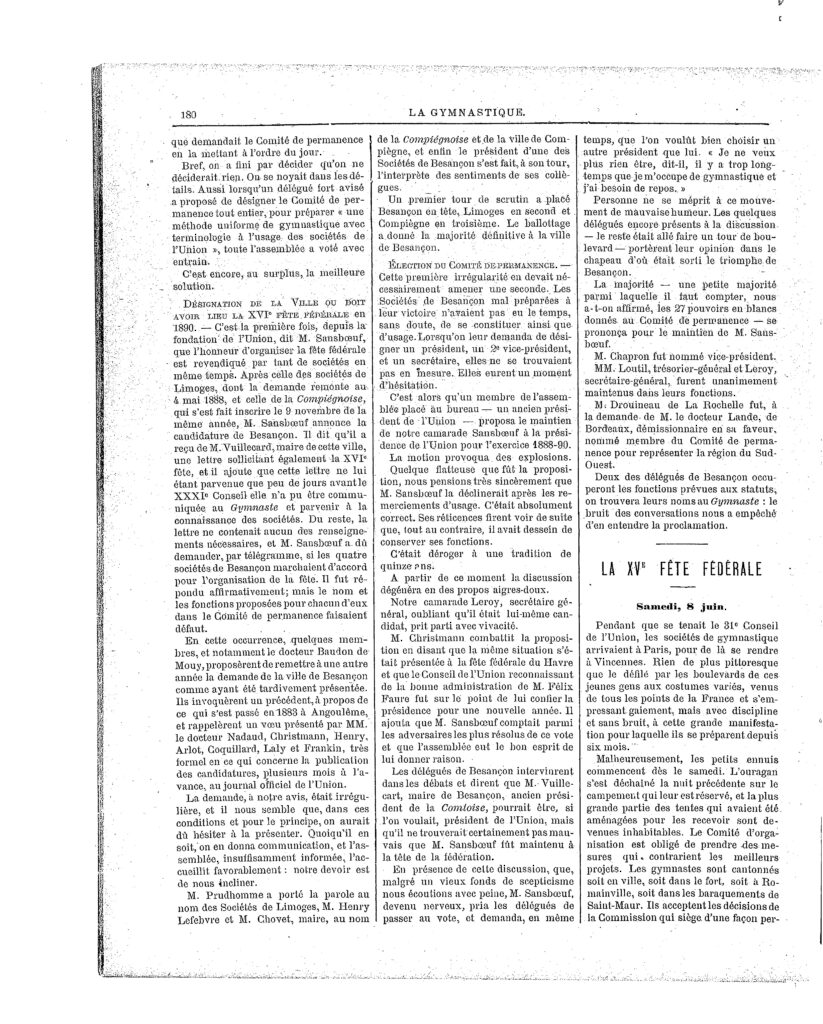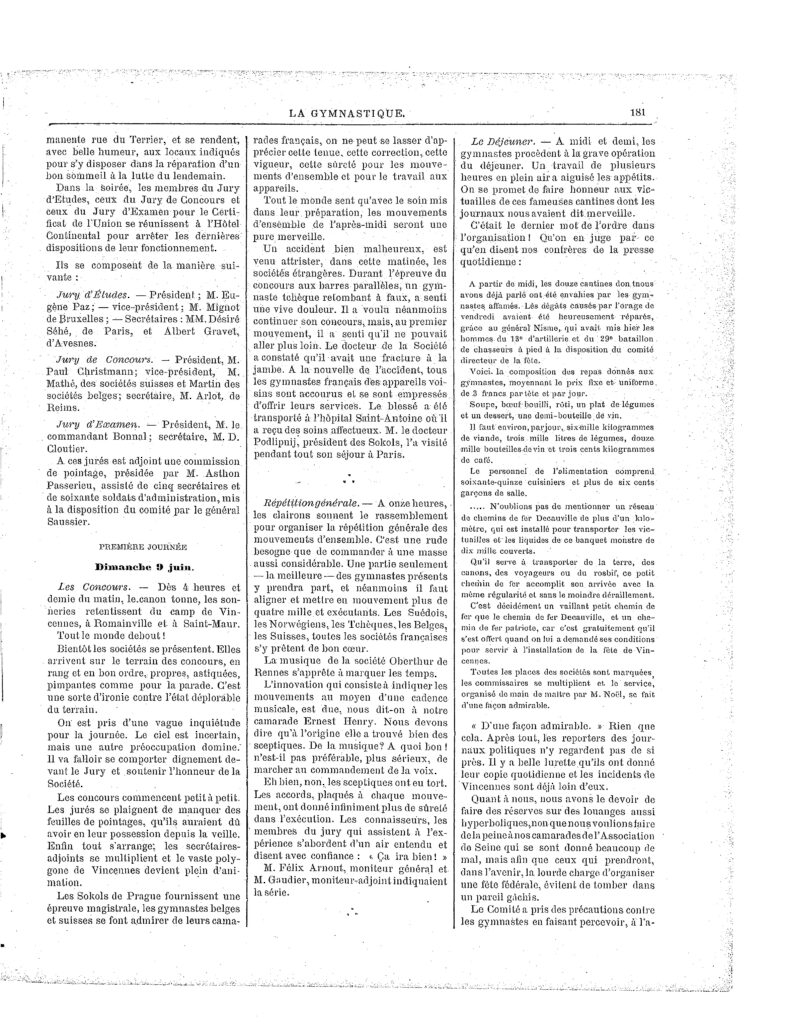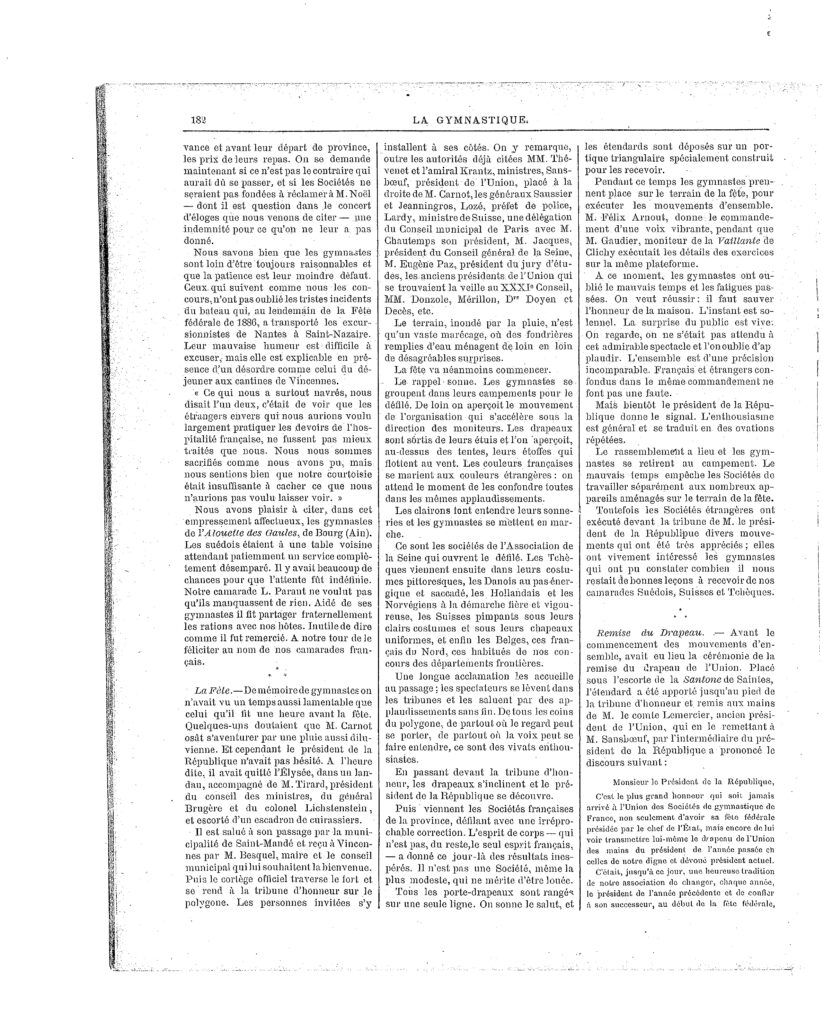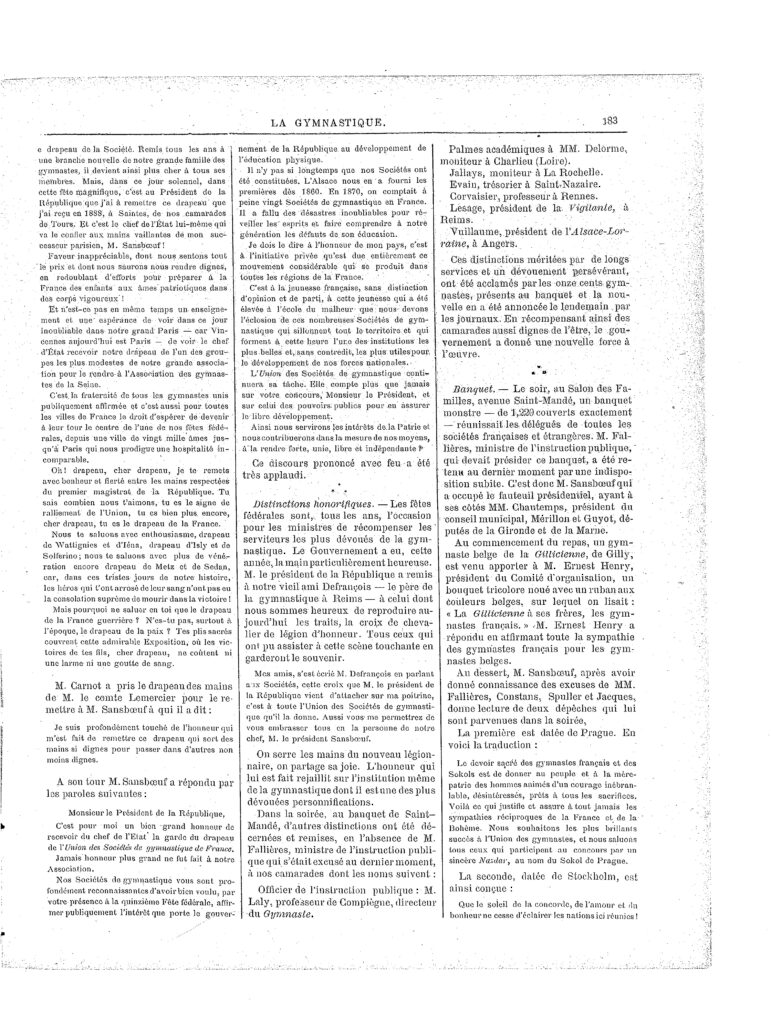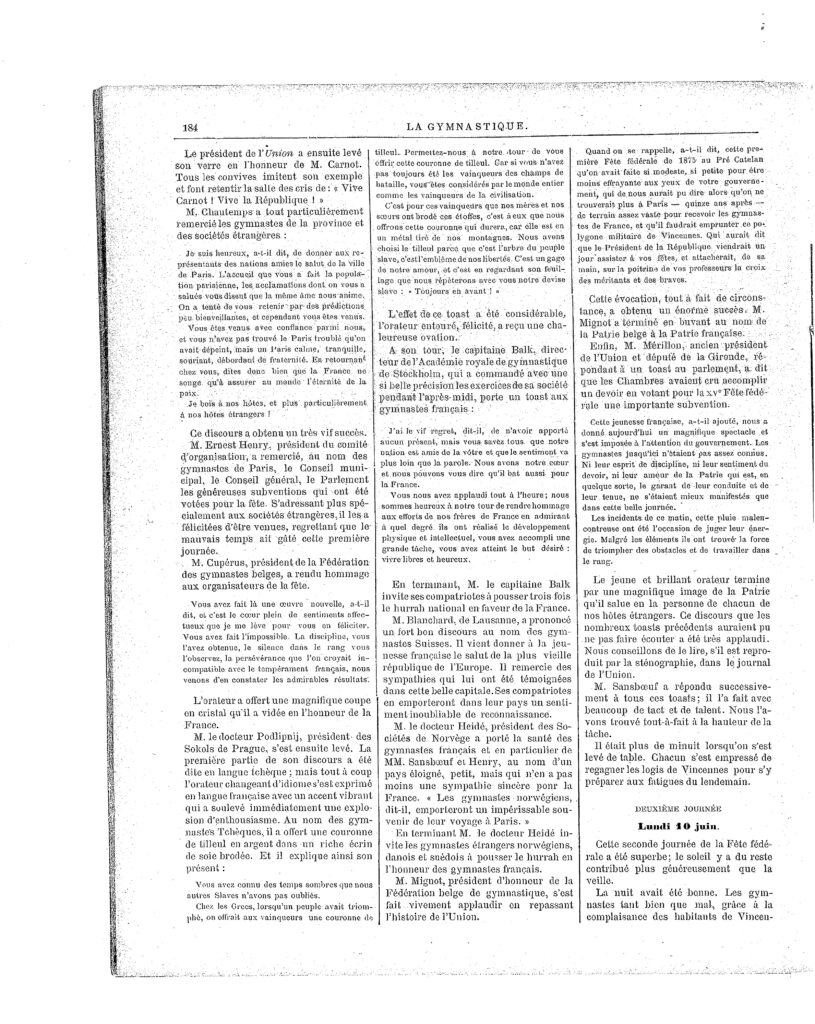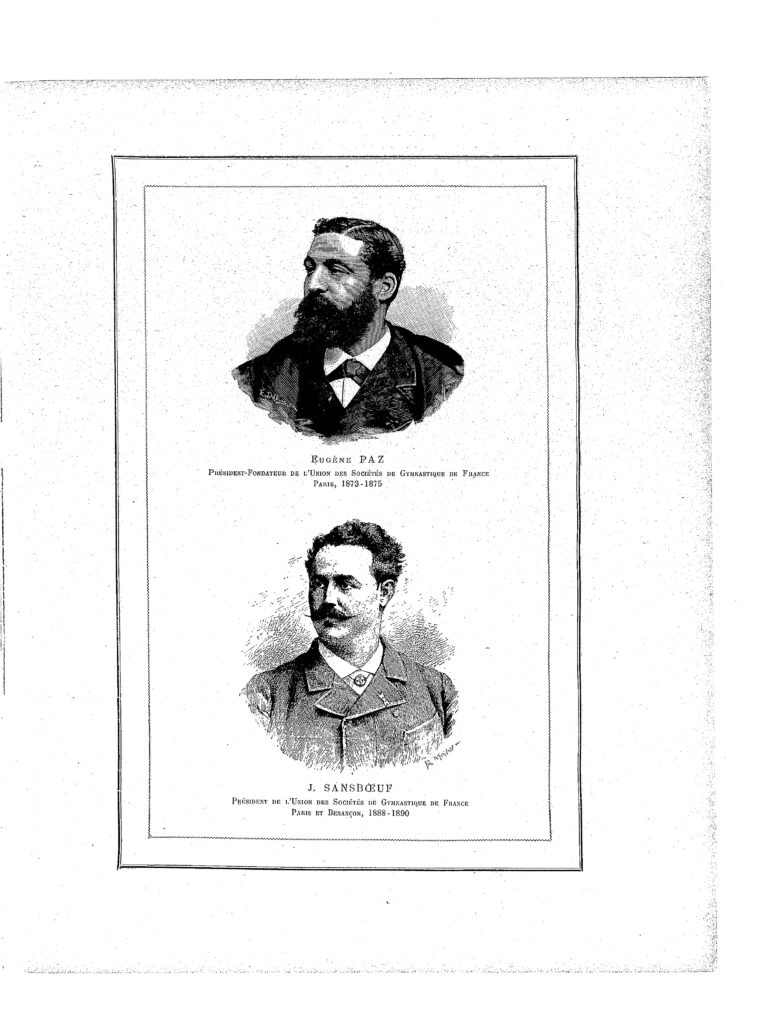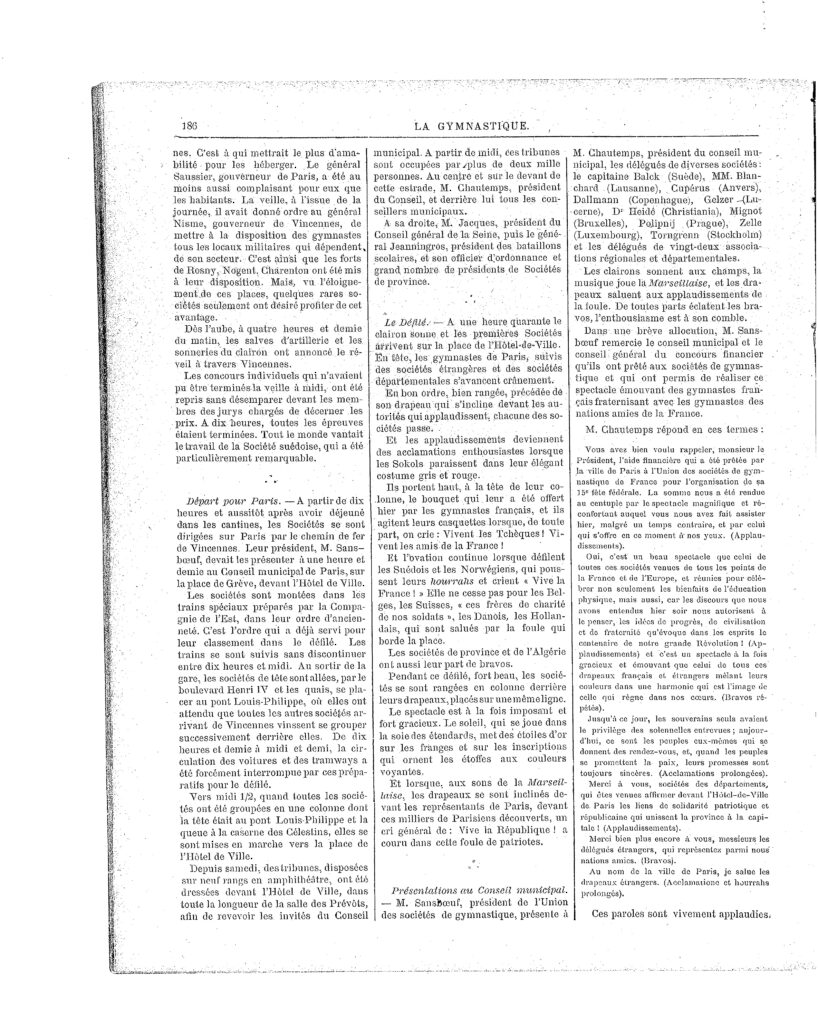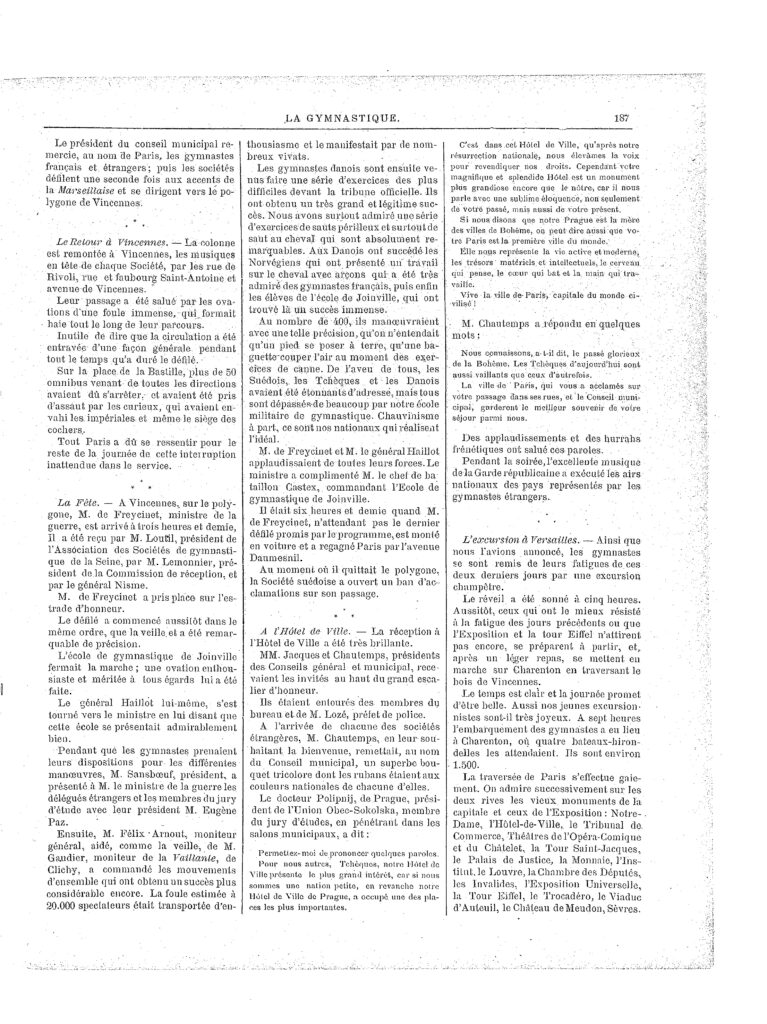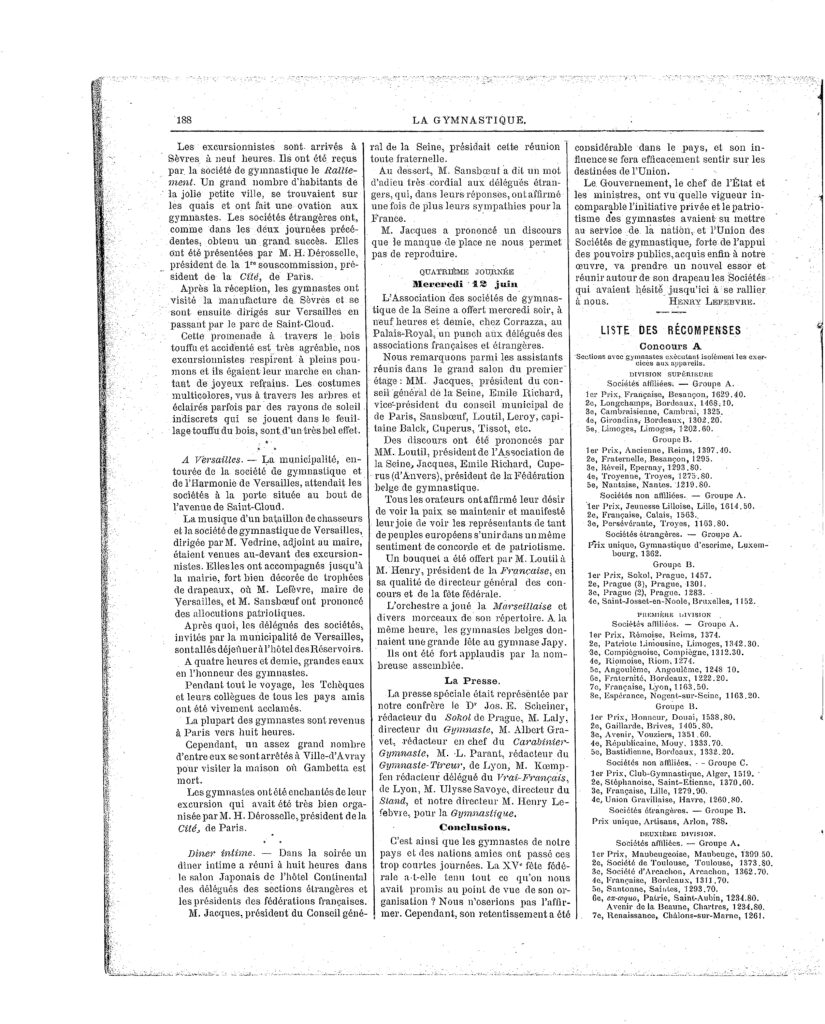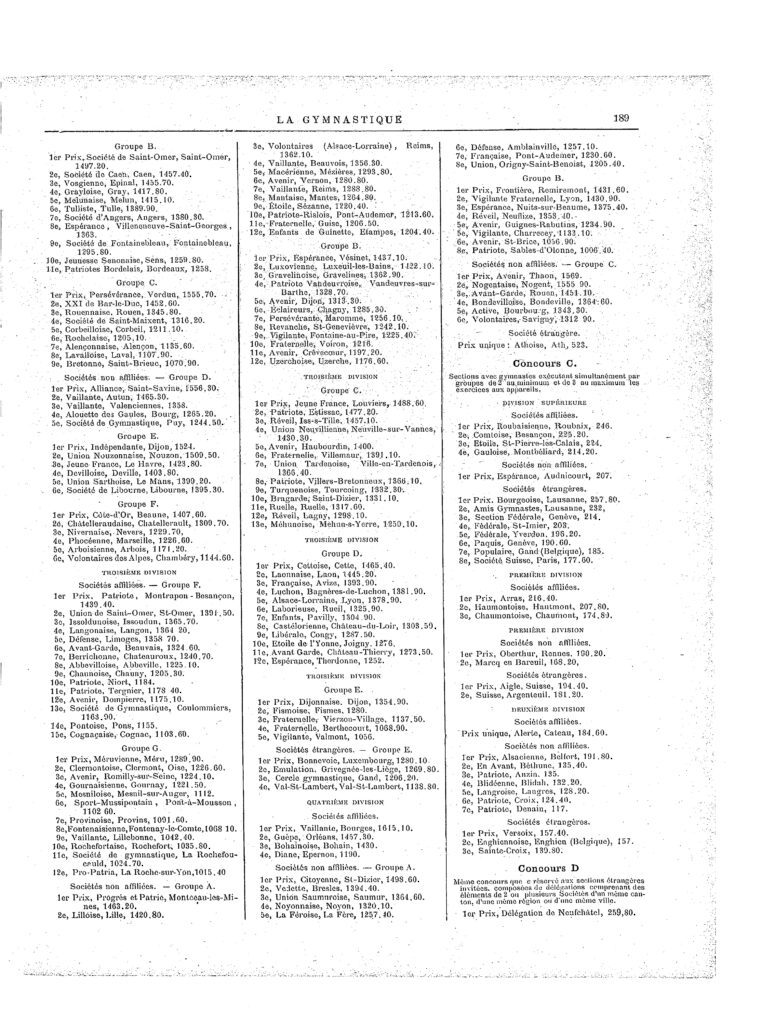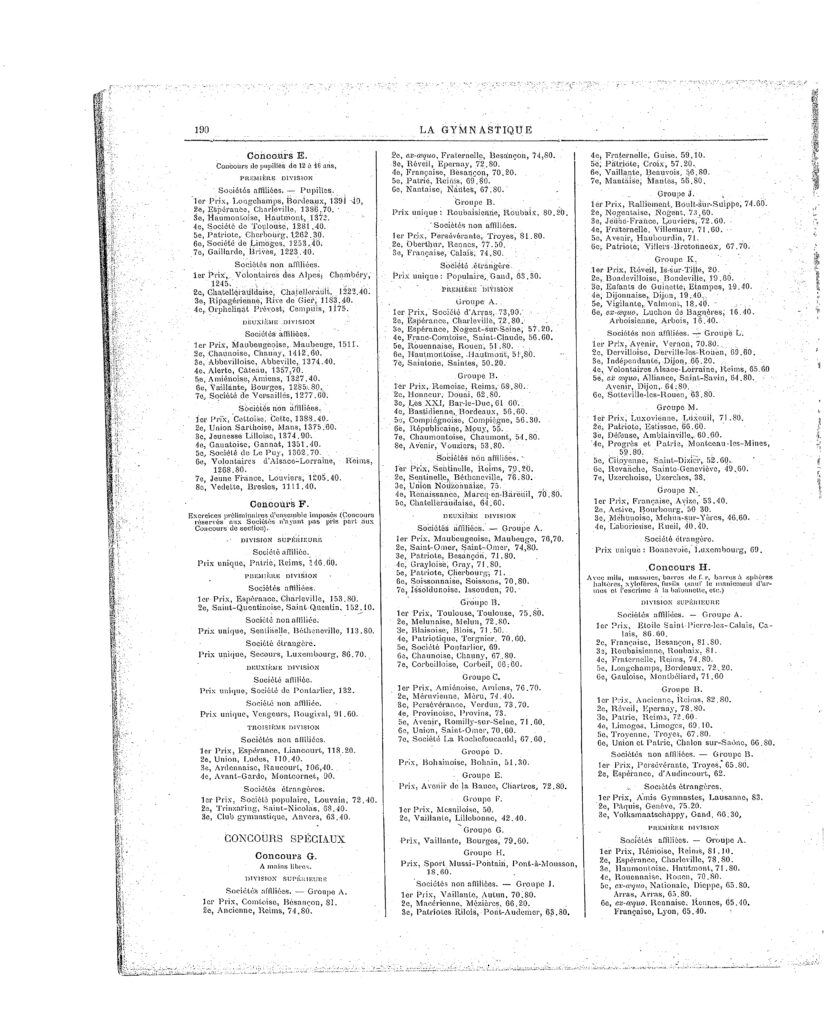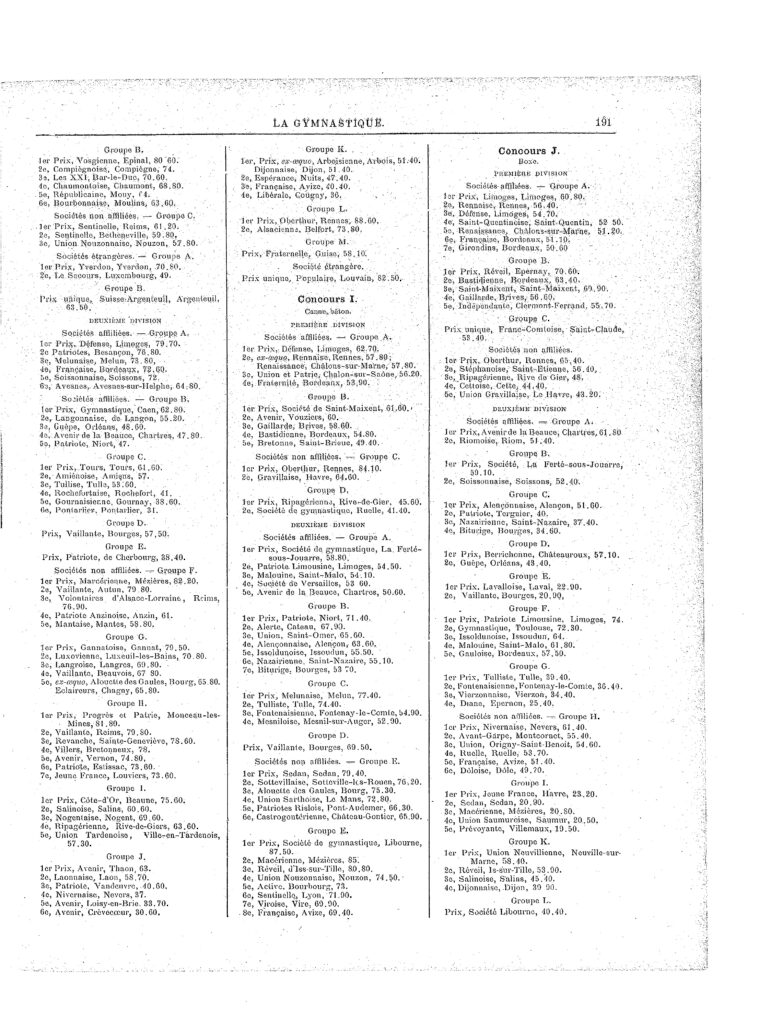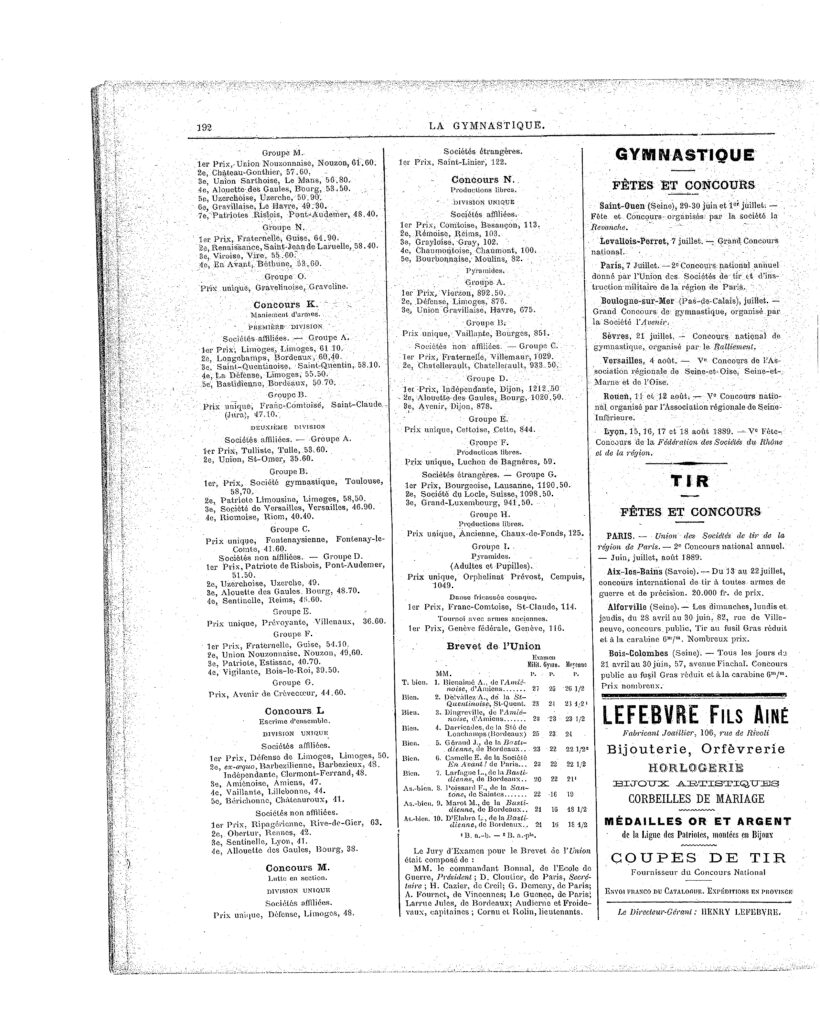Even before the first modern Olympics in 1896 and even before the first World Championships in 1903, Czech gymnasts had proven themselves to be among the top teams in Europe.
Today, we’ll dive into one competition: the 1889 Fête Fédérale Française de Gymnastique (French Federal Festival of Gymnastics) in Paris.
This competition became a source of pride for the Czech and Slovak Sokols in the twentieth century.
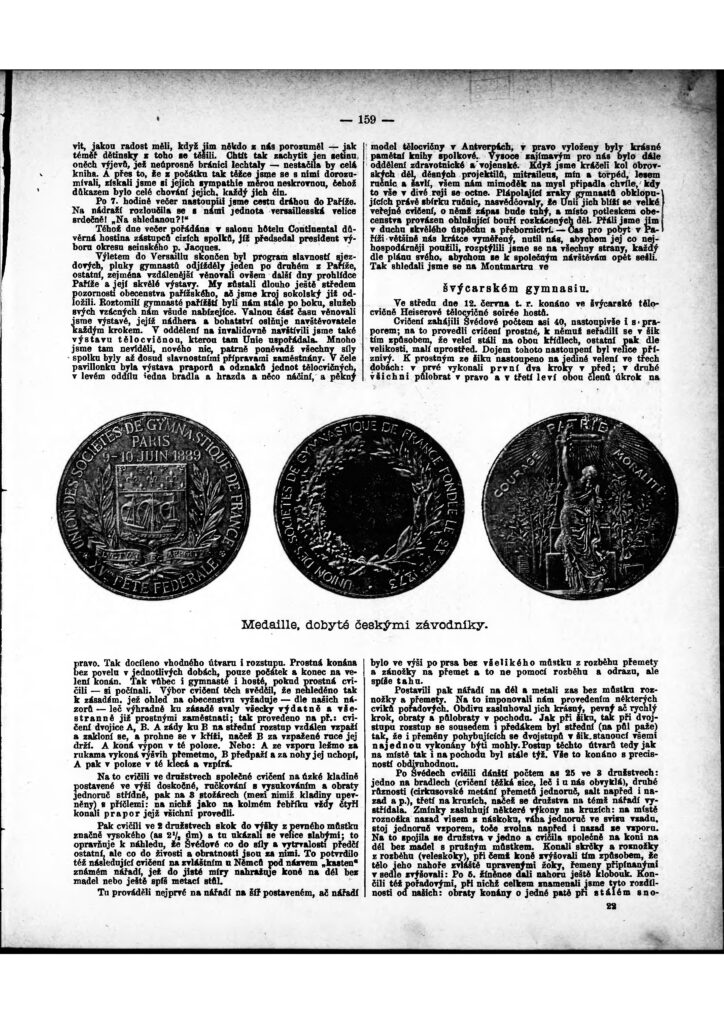
Basic Czech History | Background on the Competition | On Judging the Fête | Happenings of the Fête | Why does this matter? | Documents: Reports on the Fête
Extremely Basic Information on Czech and Slovak History
Part 1: At the time of the Fête Fédérale in 1889, the Czech and Slovak people were part of the Austro-Hungarian Empire.
Part 2: The Sokol movement was founded by Miroslav Tyrš and his father-in-law, Jindřich Fügner, in 1862. It used gymnastics as a way of trying to reestablish a Czech identity even as the Austrian Empire tried to suppress it.
Here’s an excerpt from a book written in 1948:
Through specialized studies in the departments of philosophy, art, religion, literature, natural sciences, mathematics and astronomy, and extensive travel in European countries, Dr. Tyrš widened his mental horizon and deepened his philosophical outlook. He was thus in a position to envisage and treat the problems of his nation from the higher vantage point of humanity and world history and, in doing so, came to the conclusion that neither the rebirth of a nation’s language and culture nor its political and economic revival are sufficient to guarantee a nation’s future. A nation so weakened in its physical substance and in its moral and spiritual fibre as was the Czech nation after the White Mountain must renew that physical substance, restore health and strength, re-form its character and regain its national pride and self-confidence so that it may enter the family of nations on a basis of real and acknowledged equality.
The problem was how best to achieve this end. Tyrš (and this was his great merit) found a means as simple as it was effective — physical training. From his studies of classical Greece, he made the significant discovery that among the Greeks physical training and the cultivation of the civic virtues went hand in hand. In spite of the Greeks being, like the Czechs, a small nation, physical training made them able to withstand the attacks of physically more powerful peoples.
Věnceslav Havlíček, The Sokol Festival, 1948
Background on the Competition
What was the Fête Fédérale?
It was a gymnastics competition and festival organized by the Union des Sociétés de Gymnastique de France (Union of Gymnastics Societies of France). The 15th Fête took place in June of 1889.
While most of the competitors were from France, there were many gymnasts from other countries:
Among these memberships, we would like to cite those of societies belonging to countries which are friends of France, the names of which follow in alphabetical order: Belgium, Denmark, Spain, Holland, Luxembourg, Norway, Sweden, Switzerland, Czech, Swiss and Belgian societies will come in large numbers.
Parmi ces adhésions, nous voulons citer celles des sociétés appartenant à des pays amis de la France dont les noms suivent par ordre-alphabétique : Belgique, Danemark, Espagne, Hollande, Luxembourg, Norvège, Suède, Suisse, Tchèque. Les sociétés Suisses et Belges viendront en grand nombre.
La Gymnastique et Le Moniteur officiel de la gymnastique, du tir et de l’escrime, July 28, 1889
I will abbreviate the title as La Gymnastique going forward.
Reportedly, there were over 10,000 gymnasts from 830 foreign and French societies at the Fête. (The Czech report said 12,000 gymnasts were present.)
In many ways, the 1889 competition at the French Federal Festival was more international than the first World Championships. (More on that below.)
It probably helped that the 1889 Federal Festival of Gymnastics coincided with the Exposition Universelle (World’s Fair) in Paris.
Why did the Czech gymnasts travel to Paris?
They saw it as a way to revive the Czech national identity abroad.
We do not see the Paris expedition as a world event, nor do we expect political upheavals from it; we see in it only a successful attempt to revive the Czech name abroad and make friends through the honest and noble efforts of our national citizens. In a few days of their stay in Paris, the Czech Sokols suddenly whisked away all the symphathies of most of the audience, aroused general interest in our nation, its position, abilities and strength; in short, they conquered the hearts of many successful sons and the nation of France.
K výpravě pařížské nepohlížíme sice jako k události světové, ani nečekáme od ní převratů politických, my zříme v ni jen zdařený pokus k novému oživení jména českého v cizině a získání přátel poctivým a ušlechtilým snahám našim národním. Pokus ten právem nazvati lze zdařeným, za několik dní pobytu v Paříži strhli Sokolové čeští rázem všechna sympathii valné části obecenstva jejího na se, vzbudily všeobecný zájem o národ náš, jeho postavení, schopnosti a síly, zkrátka dobyli sobě a národu svému srdce mnoha zdárných synů Francie.
Sokol, 15.7, 1889
Which competition did the Czech gymnasts win at the French Federal Festival in 1889?
There were many competitions at the Fête Fédérale, and each competition had different rules. The Czech gymnasts took the top three spots among the foreign competitors in Competition A:
1st Prize, Sokol, Prague 1457
2nd, Prague (3), Prague 1301
3rd, Prague (2), Prague, 1283
4th – Saint-Josse-ten-Noode, Brussels, 1152
(La Gymnastique, June 30, 1889)
Note: The top score for Competition A was 1629.40 from a society in Besançon, but since they were a French team, they didn’t compete directly with the Czech Sokols in Competition A.
Who was on the winning Czech team?
- Grumlík, Team Leader
- Bloudek Bolča, Engineer
- Březina Otok, Clerk
- Fiedler Karel, Medic
- Hyánek Antonín, Student
- Hron Karel, Clerk
- Pechan Jaroslav, Teacher
- Potůčka Bohům, Typographer
(Surnames listed first.)
What was Competition A?
The gymnasts competed individually on the apparatus. (“Sections avec gymnastes exécutent isolément les exercices aux appareils.”)
Here’s what they competed on:
Art. 48. – Each section must perform the following work:
1st The 6 preliminary ensemble compulsory routines, scored as an apparatus;
2nd A compulsory exercise known in advance and an optional exercise, the same for the whole section, on the high bar;
3rd A compulsory exercise known in advance and an optional exercise, the same for the whole section, on parallel bars;
4th A compulsory long jump and a compulsory high jump; these two jumps preceded by a run and scored like an apparatus.
Art. 48. — Chaque section devra exécuter le travail suivant :
1° Les 6 exercices préliminaires d’ensemble imposés, cotés comme un appareil;
2° Un exercice obligatoire connu d’avance et un exercice facultatif, le même pour toute la section, à la barre fixe (reck) ;
3° Un exercice obligatoire connu d’avance et un exercice facultatif, le môme pour toute la section, aux barres.parallèles;
4° Un saut obligatoire en longueur et un saut obligatoire en hauteur; ces deux, sauts précédés d’une course et côtés comme un appareil.
La Gymnastique, Nov. 4, 1888
Note #1: You can read more about the preliminary exercises in the report from the Copenhagen Gymnastics Societies.
Note #2: The Czech report said that this was the most difficult of the competitions:
Therefore, we signed up the team competitions in the most category, and they began to prepare diligently.
Přihlásili jsme se proto k za vodám a to k závodům družstev v oddělení nejtěžším a a jali se pilně připravovat.
Sokol: časopis zájmům tělocvičným věnovaný, 15.7, 1889
What was the total number of points for Competition A?
Short answer: 1,926 points
Long answer:
6 points: Presence Points
480 points: High Bar
2 judges x 20 = 40 x 2 exercises (compulsory and optionals) = 80 x 6 gymnasts = 480
480 points: Parallel Bars
2 judges x 20 = 40 x 2 exercises (compulsory and optionals) = 80 x 6 gymnasts = 480
480 points: Jumps
2 judges x 20 = 40 x 2 jumps = 80 x 6 gymnasts = 480
480 points: Preliminary Ensemble Exercises
Individual Execution: 180 points
1st juror 20 x 6 exercises = 120,
Add half, i.e. 60 = 180 points
Ensemble Execution: 180 points
2nd juror 20 x 6 exercises = 120
Add half, i.e. 60 = 180 points
Dress, discipline, arrival, departure: 120 points
The same jurors each giving an ensemble mark: i.e.
2 jurors x 20 = 40 x by the coefficient 3 = 120 points
Note: This wasn’t the only competition format.
While the Sokols took the top three places in a competition where gymnasts competed one at a time, there were team competitions in which the gymnasts competed simultaneously.
For example, Competition C was for:
Sections with gymnasts performing the exercises on the apparatus simultaneously in groups of at least 2 and at most 3.
Sections avec gymnastes exécutent simultanément par groupes de 2 au minimum, et de 3 au maximum les exercices aux appareils.
La Gymnastique, Nov. 4, 1888
For their optional routines in Competition C, the teams had the choice of:
high bar (reck), parallel bars, rings, free horse, pommel horse, or jumping, with a minimum of 2 gymnasts and a maximum of 3, simultaneously performing the same exercise
barre fixe (reck), barres parallèles, anneaux, cheval libre, cheval avec arçons ou saut, à 2 gymnastes au minimum et à 3 au maximum, exécutant simultanément le même exercice
La Gymnastique, Nov. 4, 1888
What was the prize for winning?
The teams won a variety of gifts, including a gold wreath and a bronze sculpture:
The Grumlík team received a golden laurel wreath, which was a gift from La Lanterne magazine, a Union medal and a magnificent bronze sculpture by [Charles] Anfice, representing a cuirassier, a wounded officer from the battlefield at Reichshoffen, carrying a revolver aimed at the enemy. The award was donated by the President of the Union of French Riflemen, Mr. Wolfuss.
Družstvu Grumlíkovu připadl zlatý věnec vavřínový, dar časopisu La Lanterne, medaille Unie a nádherné bronzové sousoší C. Anficea, představující kyrysníka, raněného důstojníka svého z bojiště u Reichshoffenu odnášejícího a revolverem na nepřítele mířícího. Cena ta darována byla předsedou Unie střelců francouzských p. Dolfussem.
Sokol: časopis zájmům tělocvičným věnovaný, 15.7, 1889
Note: Grumlík was one of the Sokol leaders.
You can see a photo of the bronze sculpture here:
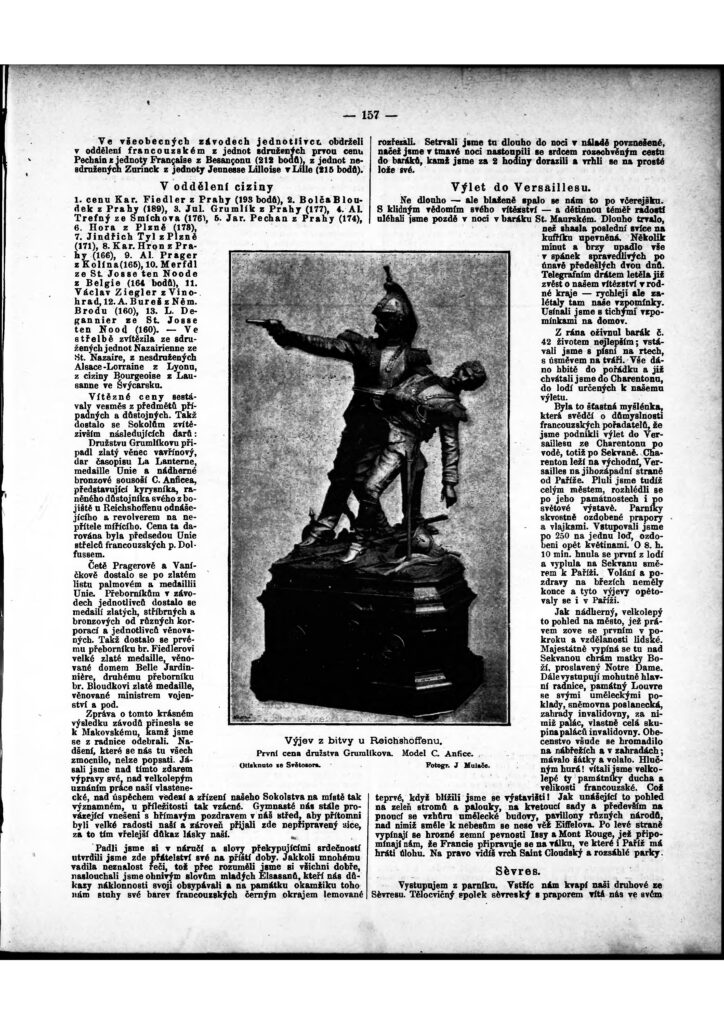
The winners in individual events won medals.
The champions in the individual competitions received gold, silver and bronze medals from various corporations and dedicated individuals. So the first champion, Brother Fiedler’s large gold medal, dedicated to the house of Belle Jardinnière, the second champion Brother Bloudek a gold medal, dedicated to the Minister of Military, etc.
Přeborníkům v závodech jednotlivců dostalo se medailí zlatých, stříbrných a bronzových od různých korporací a jednotlivců věnovaných. Takž dostalo se prvému přeborníku br. Fiedlerovi velké zlaté medaille, věnované domem Belle Jardinniěre, druhému přeborníku br. Bloudkovi zlaté medaille, věnované ministrem vojenství a pod.
Sokol: časopis zájmům tělocvičným věnovaný, 15.7, 1889
How did the Czech gymnasts prepare for this competition?
Because the Czech Sokols saw this as part of Czech revival movement, they took their training seriously.
For starters, they took only the best gymnasts.
In order for this first performance abroad to meet the desired result, it was decided to preserve it with dignity and honor; therefore, only proven and advanced competitors were selected for the competitions, who had to undergo two tests.
Aby toto naše prvé vystoupeni v cizině se žádoucím výsledkem se setkalo, usneseno až do nejmenších podrobností zachovati jemu důstojný a čestný ráz; proto především k závodům vybráni jen závodníci osvědčeni a vyspělí, kteří dvěma zkouškám podrobit se museli.
Sokol, 15.7, 1889
They had a training camp together.
After perfect preparation at their home training grounds, the competitors gathered at the end of May in Prague to be under the supervision of trainer Br. Grumlík to improve as much as possible.
Po dokonalé přípravě na domácím cvičišti sjeli se závodníci koncem května t. r. v Praze, aby tu pod dozorem cvičitele br. Grumlíka co nejvíce se zdokonalili.
Sokol, 15.7, 1889
And they had a mock competition before leaving for Paris.
The day before departure, on June 4, there was a public test of the Parisian competitors, which was held in the Sokol Prague gym.
Y den před odjezdem dne 4. června uspořádána v tělocvičně Sokola pražského veřejná zkouška závodníků pařížských.
Sokol, 15.7, 1889
How did the Fête’s judging and scoring work?
How were the routines scored?
For the score, the maximum score will be 20 (without any fraction).
0 no attempt.
From 1 to 4 bad.
From 4 to 7 mediocre.
From 7 to 10 passable.
From 10 to 13 fairly well.
From 13 to 16 well.
From 16 to 19 very well.
20 perfect.0 non essai de l’exercice.
La Gymnastique, Nov. 4, 1888
De 1 à 4 mauvais.
De 4 à 7 médiocre.
De 7 à 10 passable.
De 10 à 13 assez bien.
De 13 à 16 bien.
De 16 à 19 très bien.
20 parfait.
What was the presence score?
In the previous section, you may have noticed that six points were given for presence. Well, those were points for showing up on time.
Art. 13. — A toute Société présente sur le terrain à l’heure indiquée, il sera ajouté six points, soit sur le concours de section, soit sur le concours d’exercices préliminaires d’ensemble imposés, selon qu’elle prendra part à l’un ou à l’autre de ces concours.
La Gymnastique, Nov. 4, 1888
On Judging
The judges were responsible only for judging.
In other words, they didn’t have to worry about organizing the competition.
Art. 28. – The organization and running of the competitions being under the sole direction of the Committee management, the Jury will have to deal exclusively with the assessment of the exercises presented to it.
Art. 28. — L’organisation et la marche des concours étant sous la direction unique du Comité de direction, le Jury aura à s’occuper exclusivement, de l’appréciation des exercices présentés devant lui.
La Gymnastique, Nov. 4, 1888
The judges were gymnasts themselves.
Art. 29. – The Jury will be fully formed no later than three months before the competition by the Technical Commission of the Organizing Committee and must only be made up of gymnasts known to be competent, thus giving all the guarantees that are entitled to the competing Societies.
Art. 29. — Le Jury sera complètement formé au plus tard trois mois avant le concours par la Commission technique du Comité d’organisation et ne devra être composé que de gymnastes reconnus notoirement compétents, donnant ainsi toutes les garanties que sont en droit d’exiger les Sociétés concurrentes.
La Gymnastique, Nov. 4, 1888
Judges couldn’t judge gymnasts from their respective societies.
Art. 32. In no case may a member of the Jury be called upon to judge his Society or gymnasts belonging to it
Art. 32. En aucun cas, un membre du Jury no pourra, être appelé à juger sa Société ou des gymnastes y appartenant;
La Gymnastique, Nov. 4, 1888
Judges could not compete, nor could they be the leaders of societies.
Art. 1. — Cannot take part in any competition:
[…]
The members of the jury (the latter must in no case direct or lead a Society).
Art. 1er. — Ne pourront prendre part aux différents concours:
[…]
Les membres du jury (ces derniers ne devront en aucun cas diriger ou conduire une Société).
La Gymnastique, Nov. 4, 1888
The judging was secret until the announcement of the awards
Art. 33. – The Jury and the Management Committee will be required to keep the most absolute secrecy on the results of the competitions until the announcing of the awards.
Art. 33. — Le Jury et le Comité de direction seront tenus de garder le secret le plus absolu sur le résultat des concours jusqu’à la proclamation des récompenses.
La Gymnastique, Nov. 4, 1888
All the Rules
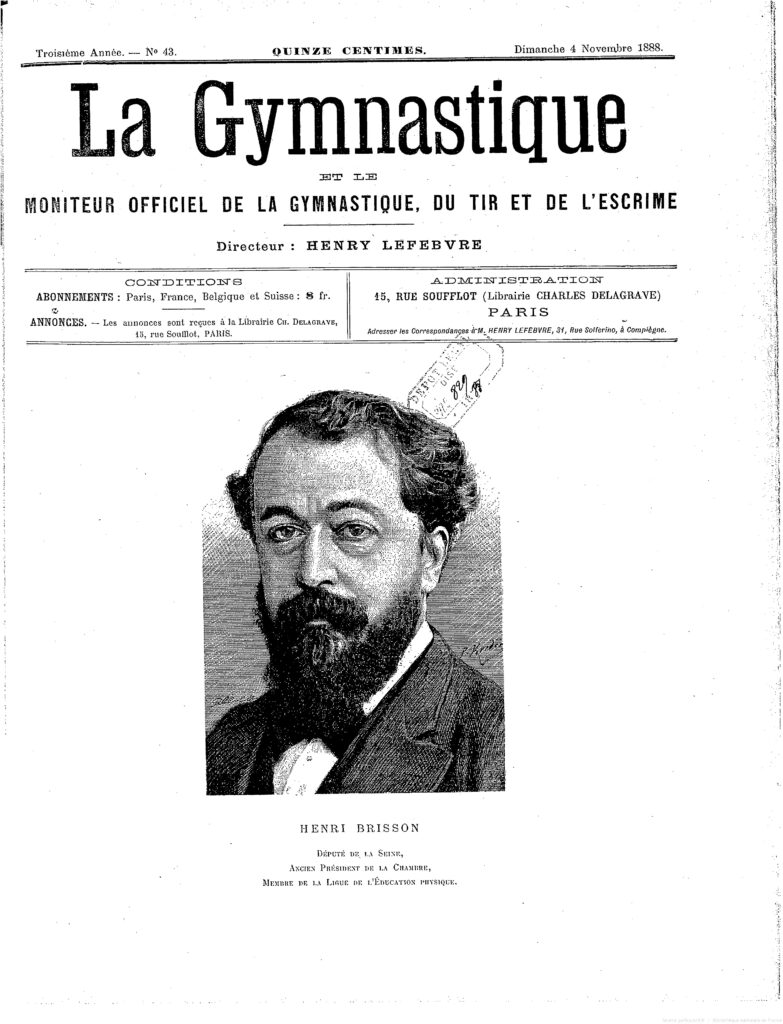
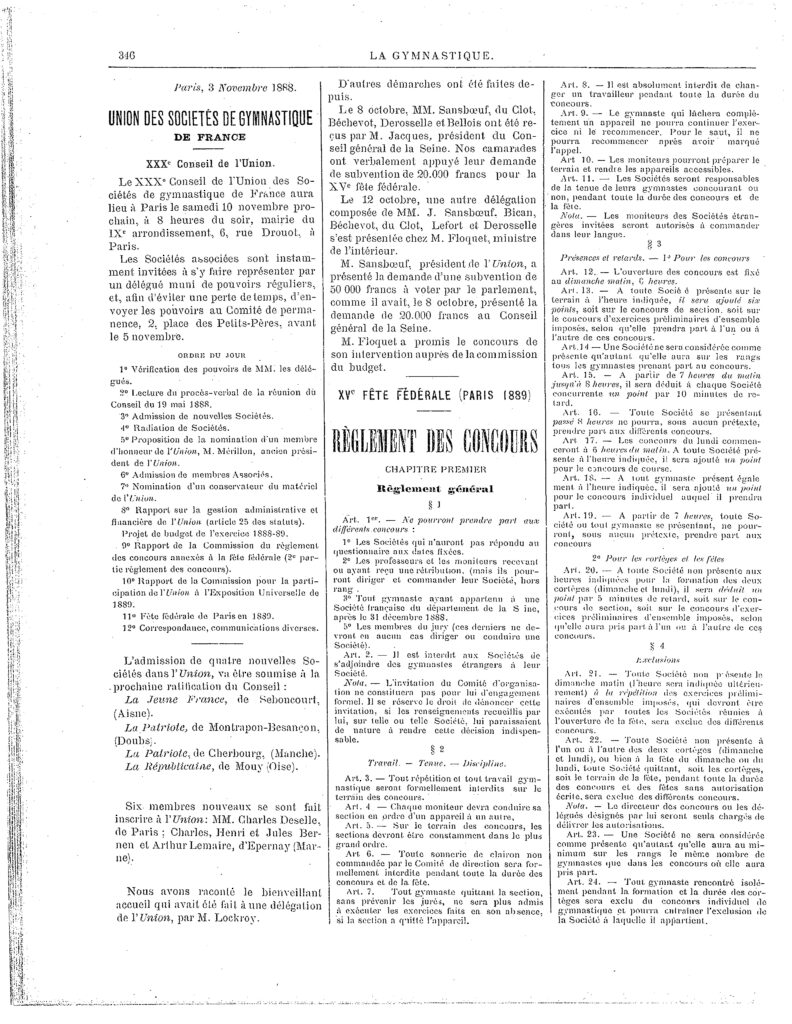
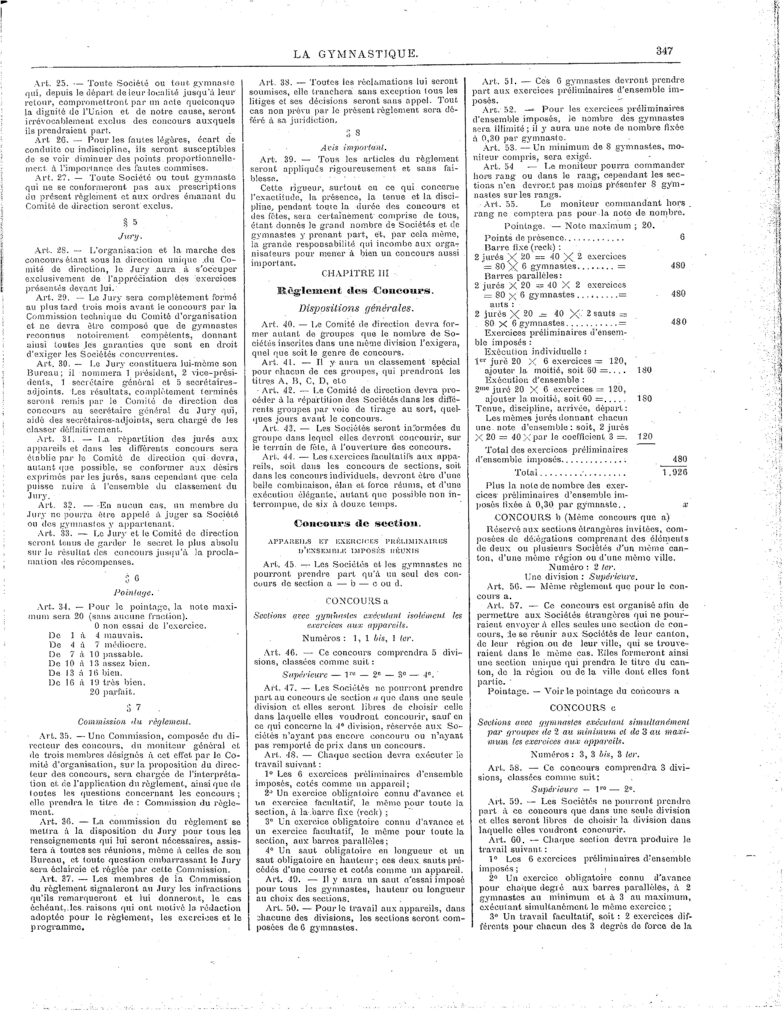
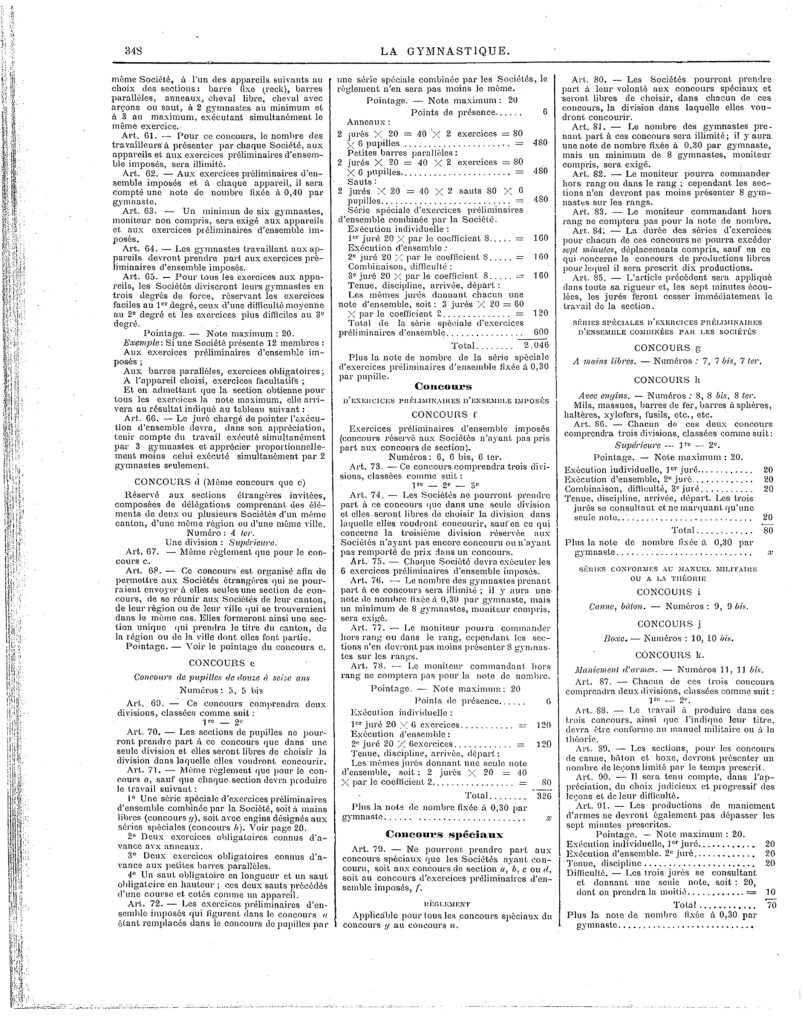
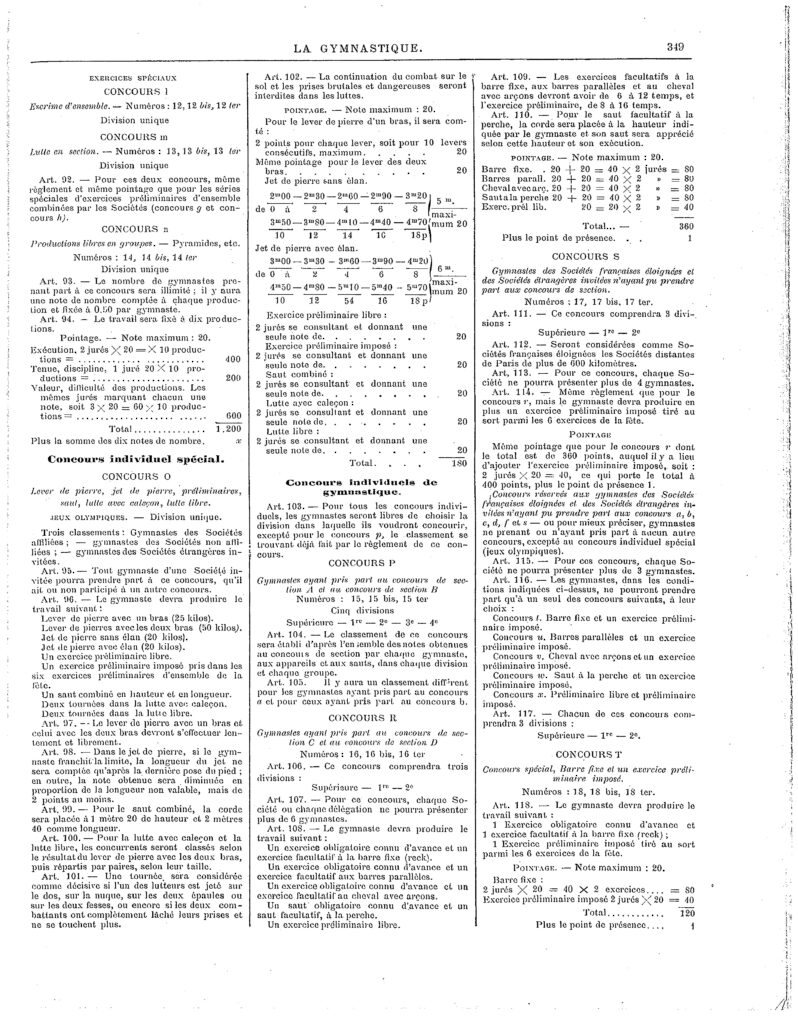
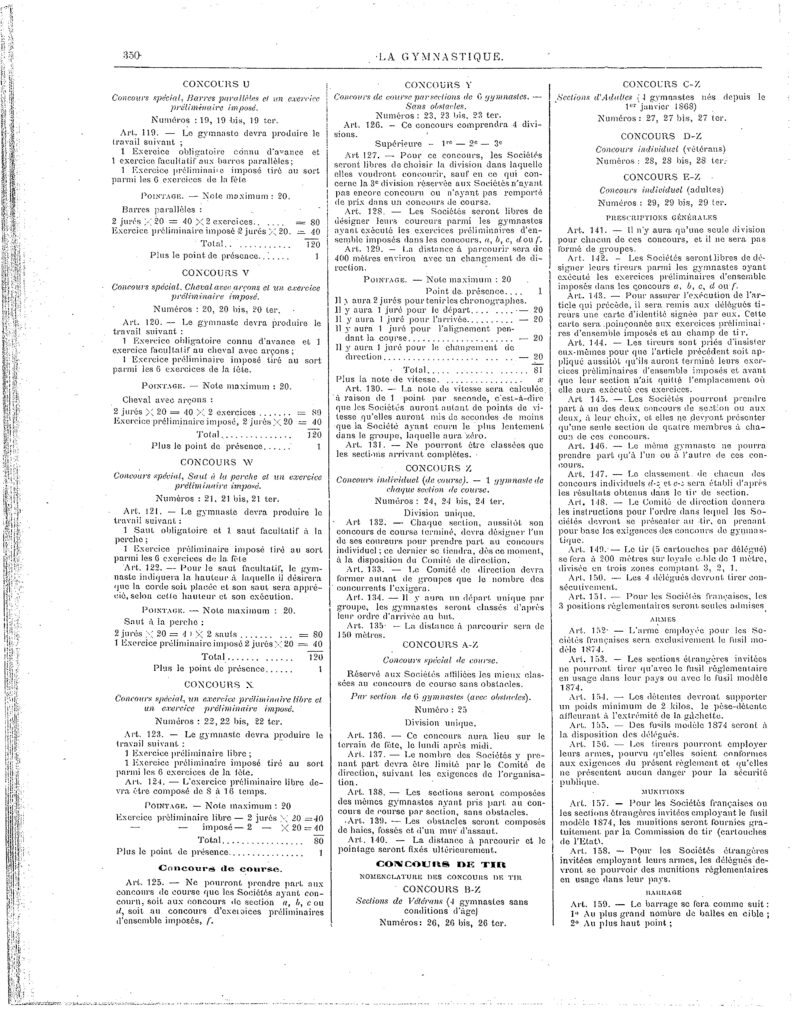
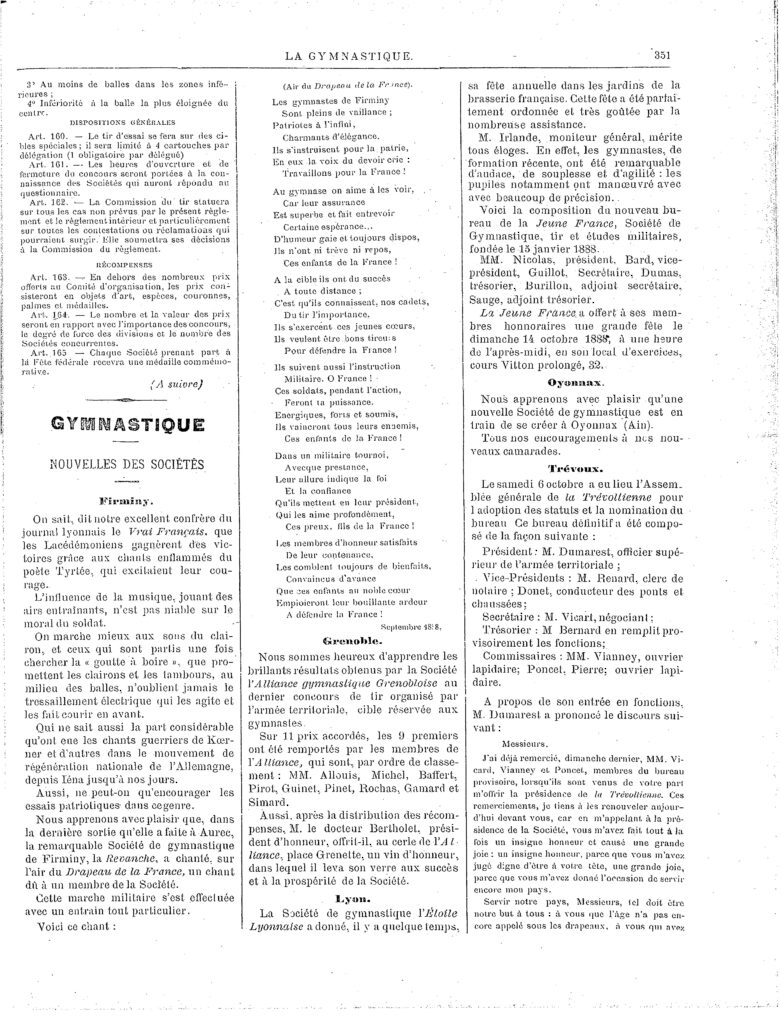
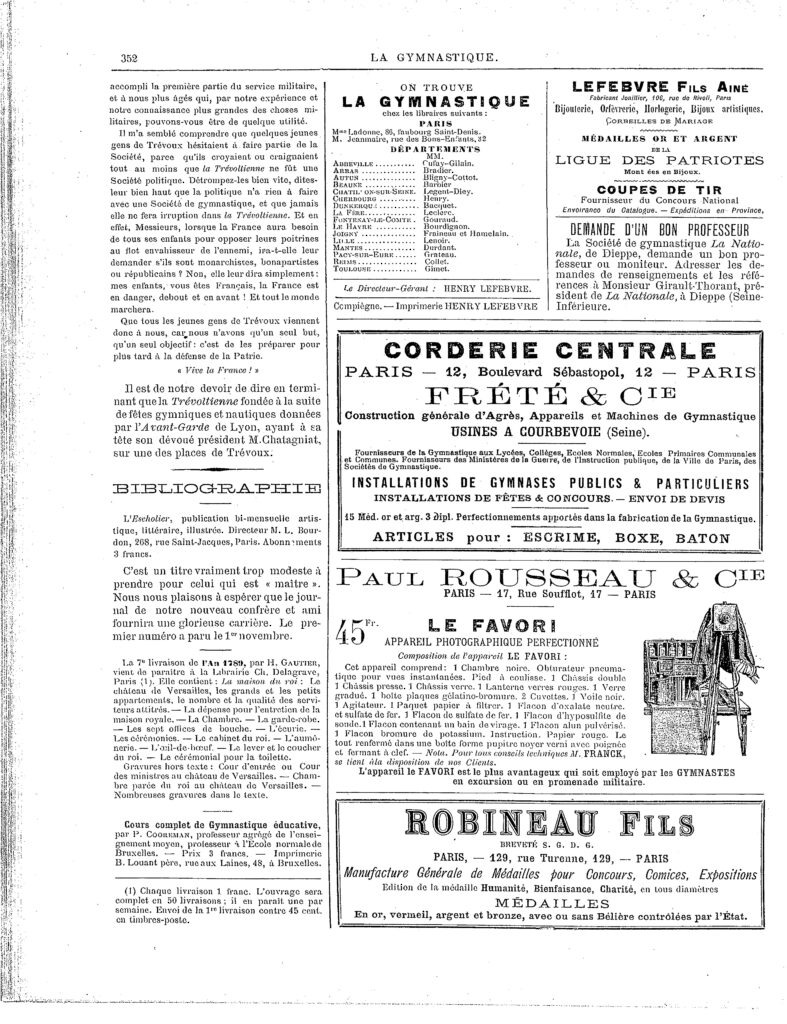
Happenings at the Fête
They woke up at 4:30 am for the competition.
From half past 4 in the morning, the cannon thunders, the bells ring out from the Vincennes camp, Romain-ville and Saint-Maur.
Dès 4 heures et demie du matin, le.canon tonne, les sonneries retentissent du camp de Vincennes, à Romain-ville et à Saint-Maur.
La Gymnastique, June 30, 1889
Things were a bit disorganized.
The competitions start little by little. The jurors complain of missing the score sheets, which they should have had in their possession since the day before.
Les concours commencent petit à petit. Les jurés se plaignent de manquer des feuilles de pointages, qu’ils auraient dû avoir en leur possession depuis la veille.
La Gymnastique, June 30, 1889
A Czech gymnast was injured on parallel bars.
A very unfortunate accident, this morning, saddened foreign societies. During the competition on the parallel bars, a Czech gymnast, upon falling, felt a sharp pain. He nevertheless wanted to continue his competition, but, upon moving, he felt that he could not continue on. The Society’s doctor found that he had a broken leg. Upon hearing the news of the accident, all the French gymnasts from neighboring apparatus came running and hastened to offer their services. The injured was transported to Saint-Antoine hospital where he received loving care. Dr. Podlipný, president of the Sokols, visited him during his stay in Paris.
Un accident bien malheureux, est venu attrister, dans cette matinée, les sociétés étrangères. Durant l’épreuve du concours aux barres-parallèles, un gymnaste tchèque retombant à faux, a senti une vive douleur. Il a voulu néanmoins continuer son concours, mais, au premier mouvement, il a senti qu’il ne pouvait aller plus loin. Le docteur de la Société a constaté qu’il avait une fracture à la jambe. A la nouvelle de l’accident, tous les gymnastes français dés appareils voisins sont accourus et se sont empressés d’offrir leurs services. Le. blessé a été transporté à l’hôpital Saint-Antoine où il a reçu des soins affectueux. M. le docteur Podlipnij, président des Sokols, l’a visité pendant tout son séjour à Paris.
La Gymnastique, June 30, 1889
The ensemble exercises were done to music, and there were skeptics.
At eleven o’clock, the bugles sound to organize the dress rehearsal of the ensemble movements. It is hard work to command such a large mass. Only a part — the best — of the gymnasts present will take part, and nevertheless it is necessary to line up and set in motion more than four thousand performers. Swedes, Norwegians, Czechs, Belgians, Swiss, all French societies willingly lend themselves to it.
The music of the Obërthur company from Rennes is about to mark the times.
The innovation, which consists in indicating the movements by means of a musical cadence, is due, we are told, to our comrade Ernest Henry. We must say that originally it found many skeptics. Music? What’s the point! Is it not preferable, more serious, to march at the command of the voice?
Well, no, the skeptics were wrong. The chords, struck with each movement, gave infinitely more certainty in the execution. The connoisseurs, the members of the jury who are present at the experiment, approach each other with a knowing air and say with confidence: “It will be fine!”
A onze heures, les clairons sonnent le rassemblement pour organiser la répétition générale des mouvements d’ensemble. C’est une rude besogne que de commander à une masse aussi considérable. Une partie seulement—la meilleure—des gymnastes présents y prendra part, et néanmoins il faut aligner et mettre en mouvement plus de quatre mille et exécutants. Les Suédois, les Norvégiens, les Tchèques, les Belges, les Suisses, toutes les sociétés françaises s’y prêtent de bon cœur.
La musique de la société Obërthur de Rennes s’apprête à marquer les temps.
L’innovation qui consiste à indiquer les mouvements au moyen d’une cadence musicale, est due, nous dit-on à notre camarade Ernest Henry. Nous devons dire qu’à l’origine elle a trouvé bien des sceptiques. De la musique? A quoi bon ! n’est-il pas préférable, plus sérieux, de marcher au commandement de la voix.
Eh bien, non, les sceptiques ont eu tort. Les accords, plaqués à chaque mouvement, ont donné infiniment plus de sûreté dans l’exécution. Les connaisseurs, les membres du jury qui assistent à l’expérience s’abordent d’un air entendu et disent avec confiance : «. Ça ira bien ! »
La Gymnastique, June 30, 1889
The Danish and Norwegian teams were impressive.
The Danish gymnasts then came to do a series of the most difficult exercises in front of the official tribunal. They have achieved great and legitimate success. We especially admired a series of dangerous somersaults and, above all, vaults which are absolutely remarkable. The Danes were succeeded by the Norwegians who presented work on the pommel horse which was greatly admired by French gymnasts, then finally the students of the Joinville school, who found immense success there.
Les gymnastes danois sont ensuite venus faire une série d’exercices des plus difficiles devant la tribune officielle. Ils ont obtenu un très grand et légitime succès. Nous avons surtout admiré une série d’exercices de sauts périlleux et surtout le saut au cheval qui sont absolument remarquables. Aux Danois ont succédé les Norvégiens qui ont présenté un travail sur le cheval avec arçons qui a été très admiré des gymnastes français, puis enfin les élèves de l’école de Joinville, qui ont trouvé là un succès immense.
La Gymnastique, June 30, 1889
Note: The Copenhagen report lists several of the vaults performed by the Danish gymnasts.
The French believed their military exercises were the best.
Numbering 400, they maneuvered with such precision, that only one foot could be heard to land on the ground, that a rod cut the air at the moment of cane exercises. By all accounts, the Swedes, the Czechs and the Danes had been amazing at addressing, but all of them are greatly overwhelmed by our military gymnastics school. Chauvinism aside, it is our nationals who realize the ideal.
Au nombre de 400, ils manoeuvraient avec une telle précision, qu’on n’entendait qu’un pied se poser à terre, qu’une baguette couper, l’air au moment dès exercices de canne. De l’aveu de tous, les Suédois, les Tchèques et les Danois avaient été étonnants d’adressé, mais tous sont dépassés de beaucoup par notre école militaire de gymnastique. Chauvinisme à part, ce sont nos nationaux qui réalisent l’idéal.
La Gymnastique, June 30, 1889
Note: The Czechs had their own criticism of the French:
Whereas the Sokol system is carried in a clear, well-arranged style and the Sokol nomenclature is concise, comprehensive and factual, summarizing everything in a few words, the Frenchman must accompany his exercises with his long sentences and interpretations in order to understand them.
Kdežto sokolská soustava y jasném, přehledném slohu nesena jest a názvosloví sokolské stručné, obsažné a věcné, málo slovy vše shrnuje, musí Francouz cvičení svá dlouhými ve: tami a výklady provázet, aby jim porozuměno bylo.
Sokol, 15.7, 1889
There were banquet speeches.
The sacred duty of French gymnasts and Sokols is to give men animated by an unshakeable courage, disinterested, ready to make any sacrifice to the people and the mother country. This is what justifies and ensures forever the reciprocal sympathies of France and Bohemia. We wish the Union of Gymnasts the best successes, and we greet all who participate in the competition with a sincere Na Zdar [cheers], on behalf of the Sokol of Prague.
Le devoir sacré des gymnastes français et des Sokols est de donner au peuple et à la mère patrie des hommes animés d’un courage inébranlable, désintéressés, prêts à tous les sacrifices. Voilà ce qui justifie et assure à tout jamais les sympathies réciproques de la France et de la Bohême. Nous souhaitons les plus brillants succès à l’Union des gymnastes, et nous saluons tous ceux qui participent au concours par un sincère [Na Zdar], au nom du Sokol de Prague.
La Gymnastique, June 30, 1889
And more banquet speeches.
Dr. Podlipný, President of the Prague Sokols, then rose. The first part of his speech was spoken in the Czech language; but suddenly, changing the idiom, the orator spoke in French with a vibrant accent which immediately aroused an explosion of enthusiasm. On behalf of the Czech gymnasts, he presented a silver linden crown in a rich embroidered silk case. And he explains his gift as follows:
You have known dark times that we, Slavs, have not published.
Among the Greeks, when a people had triumphed, the victors were offered a linden crown. Let us in turn offer you this linden wreath. Because if you were not always the victors of the battlefields, you are regarded by the whole world as the victors of civilization.
It is for these victors that our mothers and our sisters embroidered these fabrics, it is to them that we offer this crown which will last, because it is made of a metal taken from our mountains. We chose the lime tree because it is the tree of the Slavic people, it is the emblem of our freedom; It is a token of our love, and it is by looking at its leaves that we will repeat with you our Slavic motto: “Always, forward!”
M. le docteur Podlipnij, président des Sokols de Prague, s’est ensuite levé. La première partie de son discours a été dite en langue tchèque; mais tout à coup l’orateur changeant d’idiome s’est exprimé en langue française avec un accent vibrant qui a soulevé immédiatement une explosion d’enthousiasme. Au nom des gymnastes tchèques, il a offert une couronne de tilleul en argent clans un riche écrin de soie brodée. Et il explique ainsi son présent :
Vous avez connu des temps sombres que nous autres Slaves n’avons pas publiés.
Chez les Grecs, lorsqu’un peuple avait triomphé, on offrait aux vainqueurs une couronne de tilleul. Permettez-nous à notre tour de vous offrir cette couronne de tilleul. Car si vous n’avez pas toujours été les vainqueurs des champs de bataille, vous êtes considérés par le monde entier comme les vainqueurs de la civilisation.
C’est pour ces vainqueurs que nos mères et nos sœurs ont brodé ces étoffes, c’est à eux que nous offrons cette couronné qui durera, car elle est en un métal tiré de nos montagnes. Nous avons choisi le tilleul parce que c’est l’arbre du peuplé slave, c’est l’emblème de nos libertés; C’est un gage de notre amour, et c’est en regardant son feuillage que nous répéterons avec vous nôtre devise slave : « Toujours; en avant ! »
La Gymnastique, June 30, 1889
There were parades, and the Czechs were big favorites.
And the applause turns into enthusiastic cheers as the Sokols appear in their elegant gray and red suits.
They carry high, at the head of their column, the bouquet which was offered to them yesterday by the French gymnasts, and they wave their caps when, everywhere, it is shouted: Long live the Czechs! Long live the friends of France!
Et les applaudissements deviennent des acclamations enthousiastes lorsque les Sokols paraissent dans leur élégant costume gris et rouge.
Ils portent haut, à la tête de leur colonne, le bouquet qui leur a été offert hier par les gymnastes français, et ils agitent leurs casquettes lorsque, de toute part, on crie : Vivent les Tchèques! Vivent les amis de la France !
La Gymnastique, June 30, 1889
So what? Why does this festival matter?
It matters for several reasons.
I. Gymnastics before the Modern Olympics
It’s important to recognize that there were international gymnastics competitions before the first Olympic Games and the first World Championships.
In many ways, the 1889 competition at the French Federal Festival was more international than the first World Championships.
In 1903, only four countries — Belgium, France, Luxembourg, and the Netherlands — participated in the Belgian Federal Festival. (According to 100 Years of the FIG, Italy traveled to the meet, but when they saw the strength of the French team, they decided to watch as spectators.)
Note: In 1903, Belgian Federal Festival was called “le Premier Tournoi International de Gymnastique” (“the First International Tournament of Gymnastics”) — not “le premier Championnat du Monde de Gymnastique” (“The First World Championship”).
But the FIG now considers the 1903 Belgian Federal Festival to be the first World Championships.

II. Music and Men’s Gymnastics
As we saw in this post, there was precedent for men competing to music, but there were skeptics. A century later, this debate has not disappeared. It crops up every so often — as we’ll see in upcoming posts.
III. Long-Held Expectations of Judges
In 1889, the judges were expected to be gymnasts themselves.
That same notion has been reinforced and codified in different ways over the years. For example, it was written into the 1968 Men’s Code of Points:
As mentioned in the beginning, the judge’s own abilities and knowledge as a former gymnast, technical know-how and skill, continuous observation of the trends and development in artistic gymnastics, nationally and internationally, and unrestricted knowledge of the rules and regulations are necessary for conscientious judging.
1968 Code of Points, Article 71.E.2
IV. Origin Stories
This competition was a source of pride for Czech and Slovak Sokols.
I fell down this rabbit hole because of the book Fiftieth Anniversary of the Slovak Gymnastic Union Sokol in U.S.A. 1896-1946. Like many origin stories, the details aren’t quite right:
After many objections by the Austrian authorities, permission was obtained in 1889 to found a national Sokol body known as the Czech Sokol Union. It embraced eleven Districts, representing 152 units, with a total membership of 18,000. In 1889, the Sokols sponsored a delegation and gymnastic team to the International Gymnastic Association meet in Paris where the Sokol team won the first three places in open competition.
Note: As was noted above, this wasn’t an FIG event. In fact, the FIG didn’t even exist at this point. In 1881, Belgium, France, and the Netherlands established a governing body: the Fédération Européenne de Gymnastique. In 1921, that federation changed its name to the Fédération Internationale de Gymnastique.
Regardless, this competition was an essential element of the Sokol origin story.
Interesting tidbit: the Czech report on the 1889 Fête was prophetic, in that it predicted the importance of this event for the Czech people. These sentences are in the opening paragraph of the report:
We interpret this great enterprise as the greatest of the deeds done by the Sokols to date, which will remain a great, radiant point for the foreseeable future, the light of which will accompany us on the path to the glory and well-being of our dear homeland.
S mele čítáme velký tento podnik k největším z činů Sokolstvem dosnd provedených, který zůstane do daleké budoucnosti skvělým, zářivým bodem, jehož svit provázet nás bude na dráze za slávou a zdarem drahé vlasti naší.
Sokol: časopis zájmům tělocvičným věnovaný, 15.7, 1889
V. Expanding Our Historiography
Czech gymnasts were among the top gymnasts in Europe for decades. But contemporary English-language histories of gymnastics tend to overlook that fact.
That’s because modern gymnastics historians tend to look at the sport through the lens of today. They ask the question, “How did we get to where we are today?”
As a result, gymnasts like Věra Čáslavská are treated as aberrations because neither the Czech Republic nor Slovakia is a top program nowadays. In reality, Čáslavská wasn’t an aberration, but rather, part of a long legacy of top gymnasts.
VII. What if…?
It’s fun to think about the “what ifs” of life.
Gymnasts now perform one at a time on the apparatus. But what if, say, Competition C had taken hold? What if the dominant form of gymnastics had become synchronized routines on the apparatus?
In fact, at the 1896 Olympics, gymnasts performed ensemble exercises on parallel bars and high bar.
Up next: The role that the Sokol movement and an international gymnastics festival played in the defection of Marie Provazníková, the President of the Women’s Technical Committee, in 1948.
Appendix: Reports on the Fête
The Czechs
The Czech Sokols created an illustrated report on the Fête, which is included below. Here’s what Le Gymnastique wrote about it:
Our colleague Dr. J.-E. Scheiner has just published, in a special illustrated edition, the report of the 15th federal holiday. The engravings are executed with great taste and precision; the text is in Czech language.
By courtesy, of which we have already been given so much evidence, the preface is in French. It deserves to be read in its entirety.
Gentlemen and dear Comrades,
After the beautiful days of our federal festival, we returned to the paternal home with joy and enthusiasm in our hearts. We have seen thousands of sons of France compete to win, before the eyes of the nation, the palm of honor in this noble work; we have witnessed the great triumph of our common cause and the great love with which you, the French people, have accompanied your first enterprise.
We Czech gymnasts, who have dedicated our services to our small but very dear homeland, we keep indelible in our hearts the memory of the beautiful days we spent with you, and with us, are the thoughts and hearts of all our little people who are heading towards you, from this people who for centuries have harbored a love for your nation, which is called idolatry.
Accept, dear comrades, our deep gratitude for the noble feelings you have shown us; rest assured that there is not a heart here that does not beat in unison with yours, and receive this little gift in memory of our great federal holiday.
Long live noble France!
Cheers! [In Czech]
Long live the union of the Gymnastics Societies of France!
Prague, July 10, 1889
Notre confrère M. le docteur J.-E. Scheiner vient de faire paraître, en une édition spéciale illustrée, le compte rendu de la XVe fête fédérale. Les gravures en sont exécutées avec beaucoup de goût et d’exactitude ; le texte est en langue tchèque.
Par une courtoisie dont on nous a déjà donné tant de preuves, la préface est en française. Elle mérite d’être lue tout entière.
Messieurs et très chers Camarades
Après les belles journées de notre fête fédérale, nous sommes rentrés au foyer paternel la joie et l’enthousiasme au cœur. Nous avons vu des milliers de fils de la France entrer en lice pour emporter, sous les yeux de la nation, la palme d’honneur dans cette noble oeuvre; nous avons été témoins du grand triomphe de notre cause commune et du grand amour avec lequel le peuple français a accompagné votre première entreprise.
A cette occasion, vous avez manifesté pour nous autres, pauvre petite poignée des fils de la Bohême, des sentiments de si rare amabilité et de si douce complaisance, que vous nous avez attachés ainsi par des liens de gratitude infinie et d’amitié à tout jamais fidèle.
Messieurs et très chers Camarades
De même que votre grand et généreux peuple a toujours porté très haut, à. L’avant- garde de l’humanité, le flambeau de la Liberté, Égalité, Fraternité, marchez, dignes fils de vos ancêtres, les premiers dans les rangs de ceux qui cultivent notre cause commune, cette belle cause qui nous a tous réunis sous les plis des drapeaux des Sociétés de gymnastique.
Nous autres, gymnastes tchèques, qui avons voué nos services à notre petite mais très chère patrie, nous gardons indélébile dans nos coeurs la mémoire des beauxjours que nous avons passés auprès de vous, et avec nous ce sont les pensées et les coeurs de tout notre petit peuple qui se dirigent vers vous, de ce peuple qui depuis des siècles abrite pour votre nation un amour qui s’appelle idolâtrie.
Agréez, chers camarades, notre profonde gratitude pour les nobles sentiments que vous nous avez montrés; soyez assurés qu’il n’y a pas un cœur chez nous qui ne batte à l’unisson avec le vôtre, et recevez ce petit cadeau en souvenir de notre grande fête fédérale.
Vive la noble France!
Na Zdar!
Vive l’union des Sociétés de gymnastique de France !
Prague, le 10 juillet 1889
Le Gymnastique, August 11, 1889
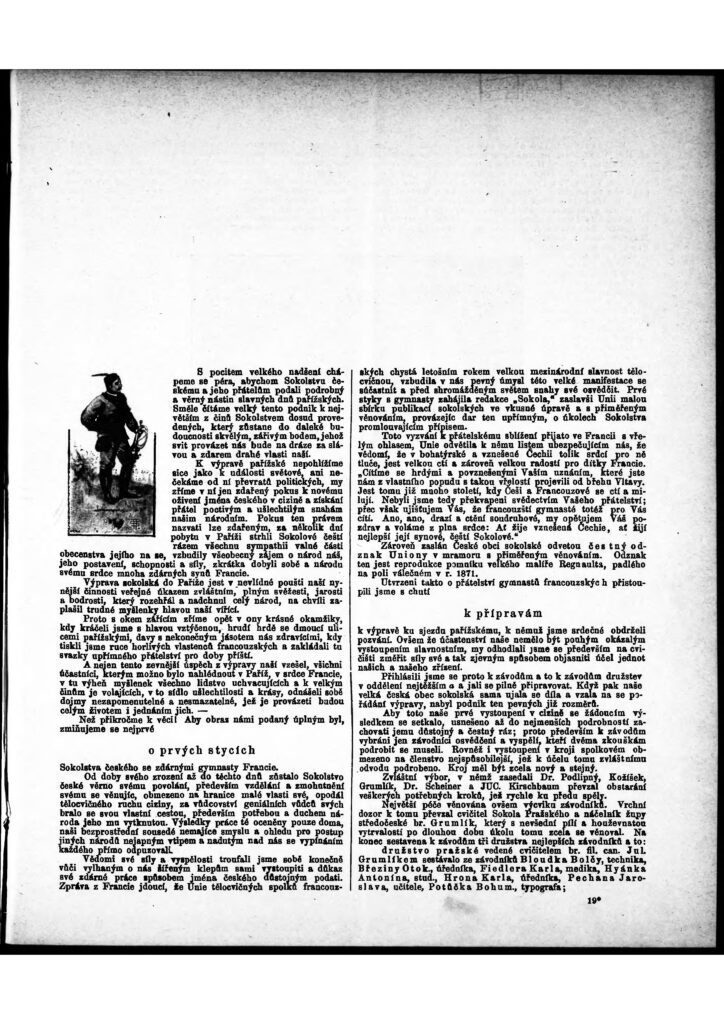
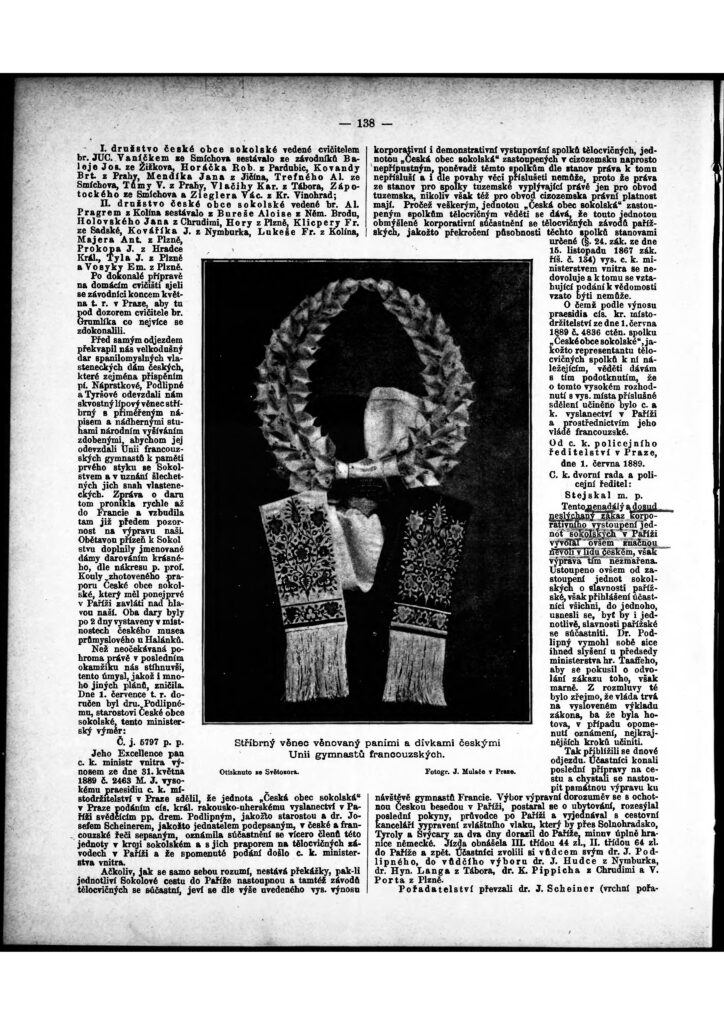
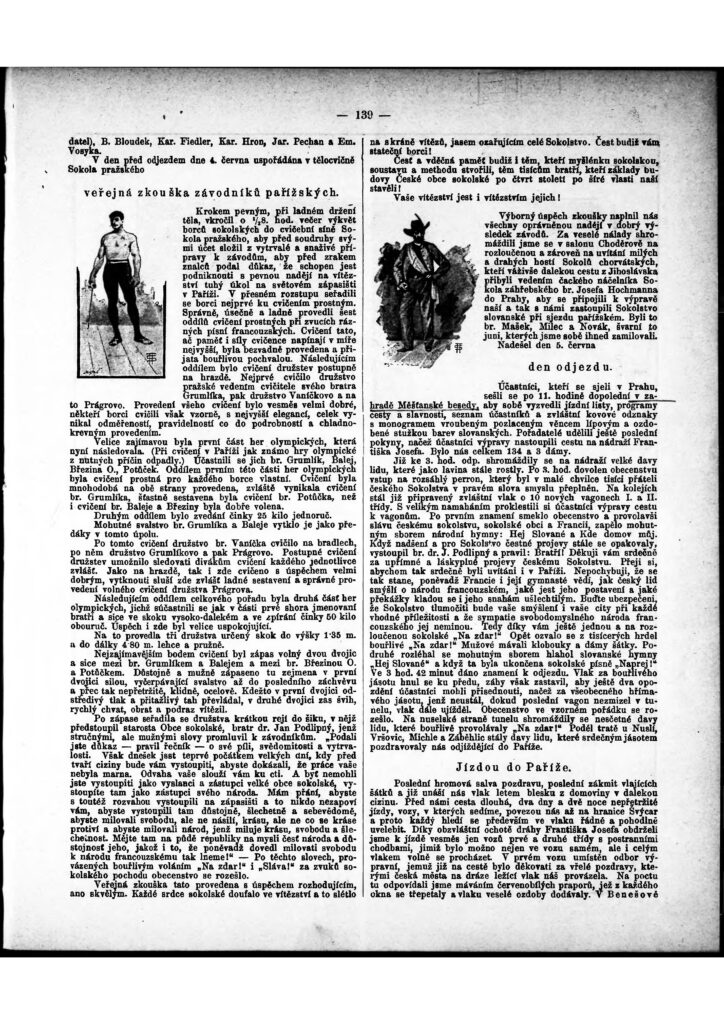
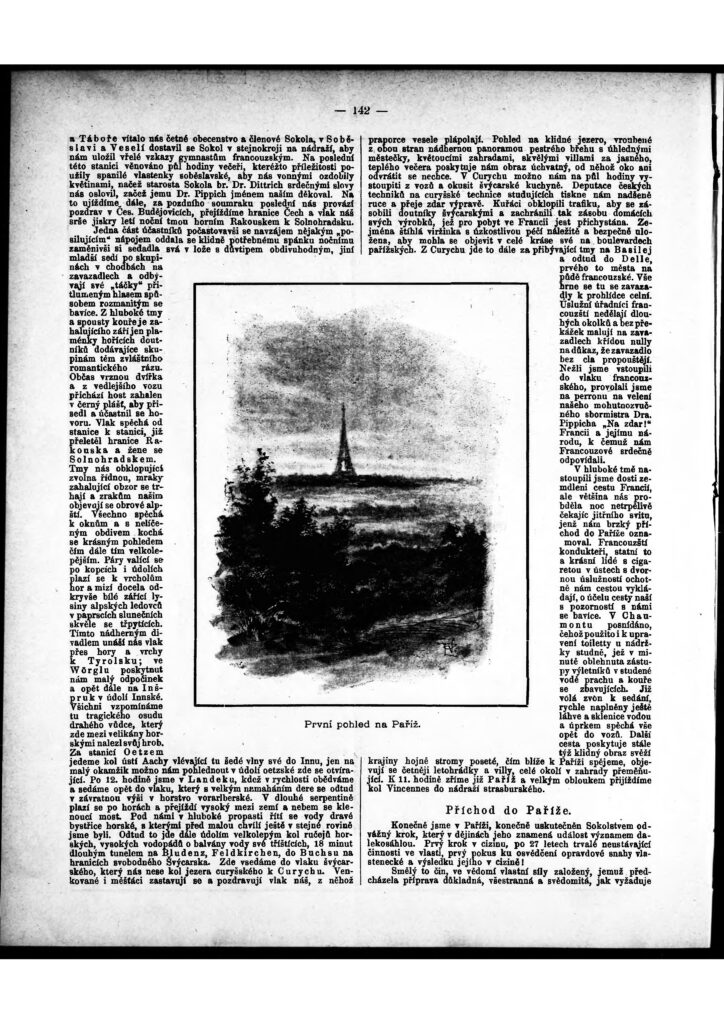
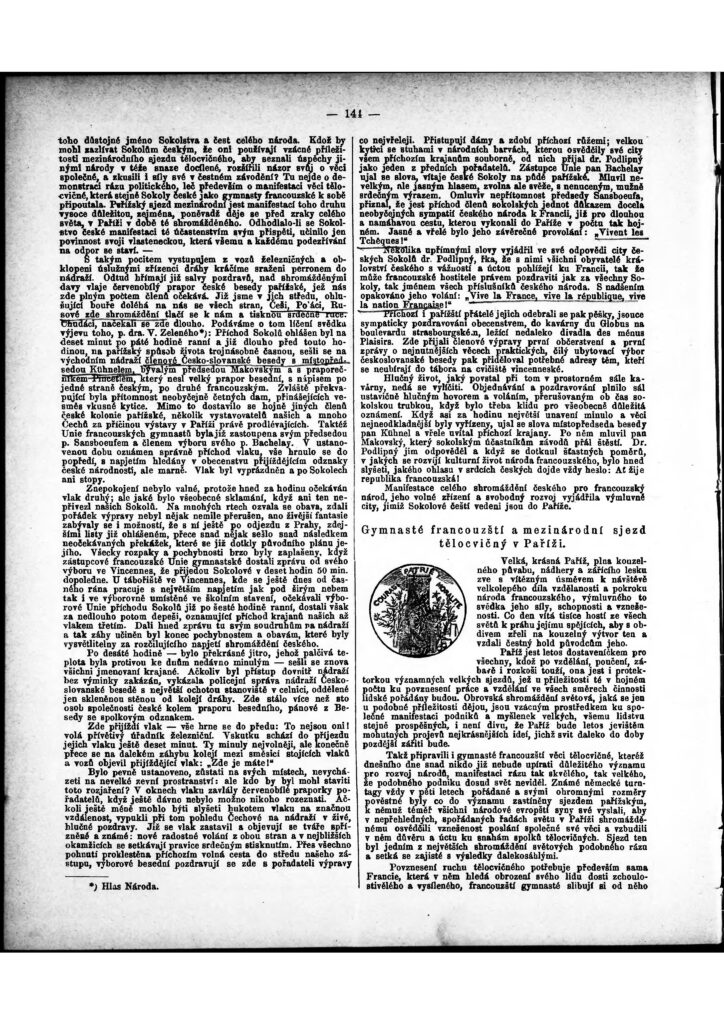
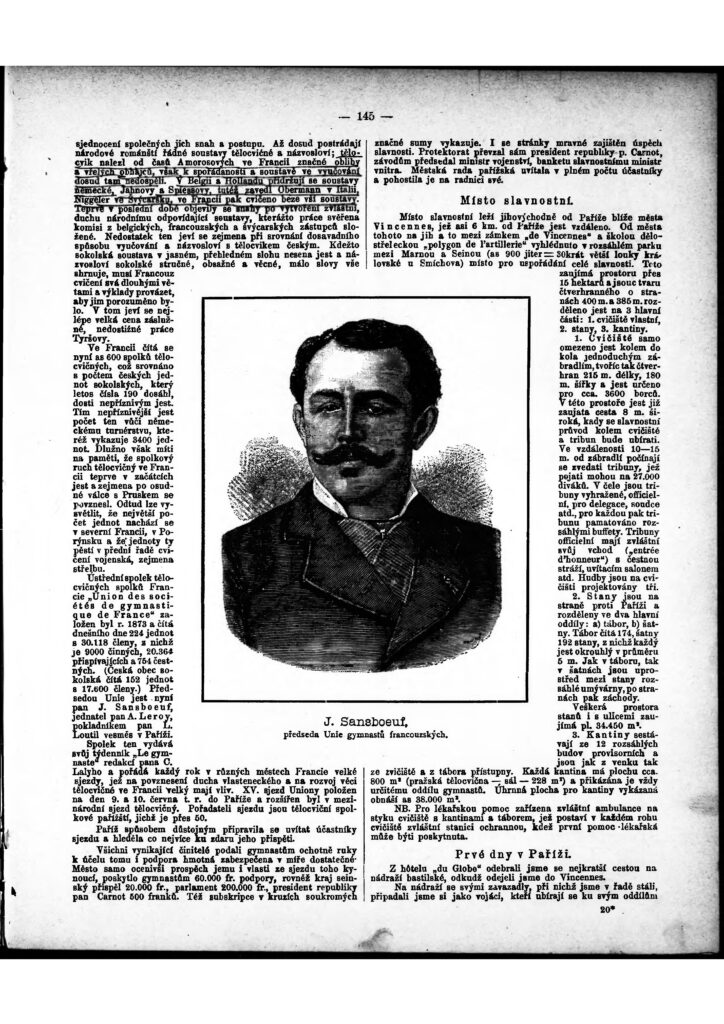
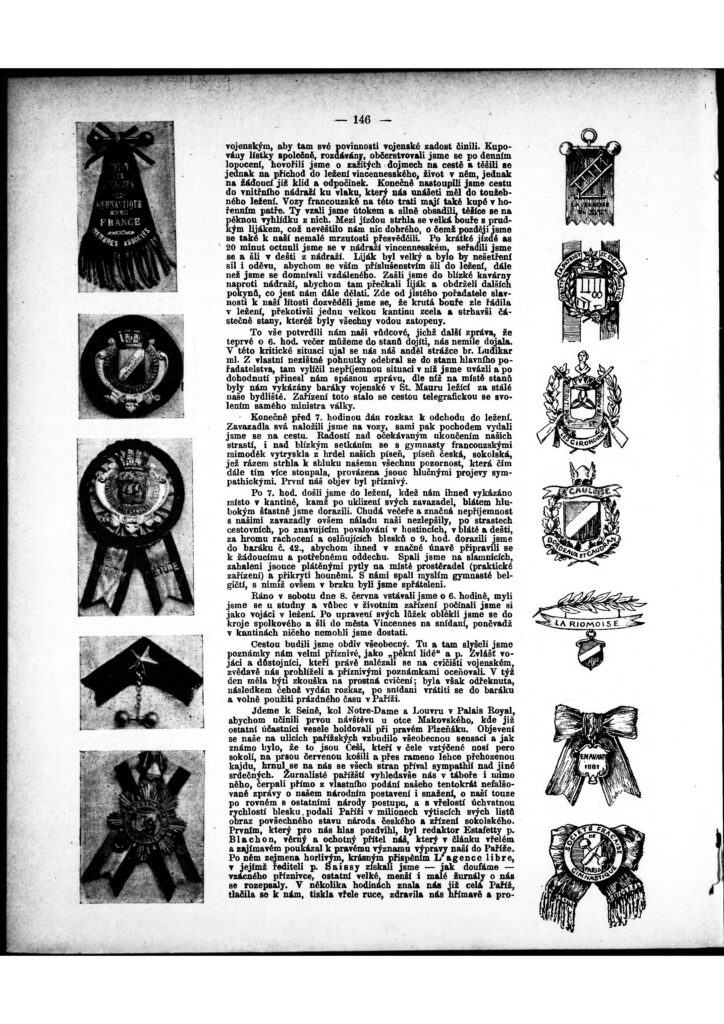
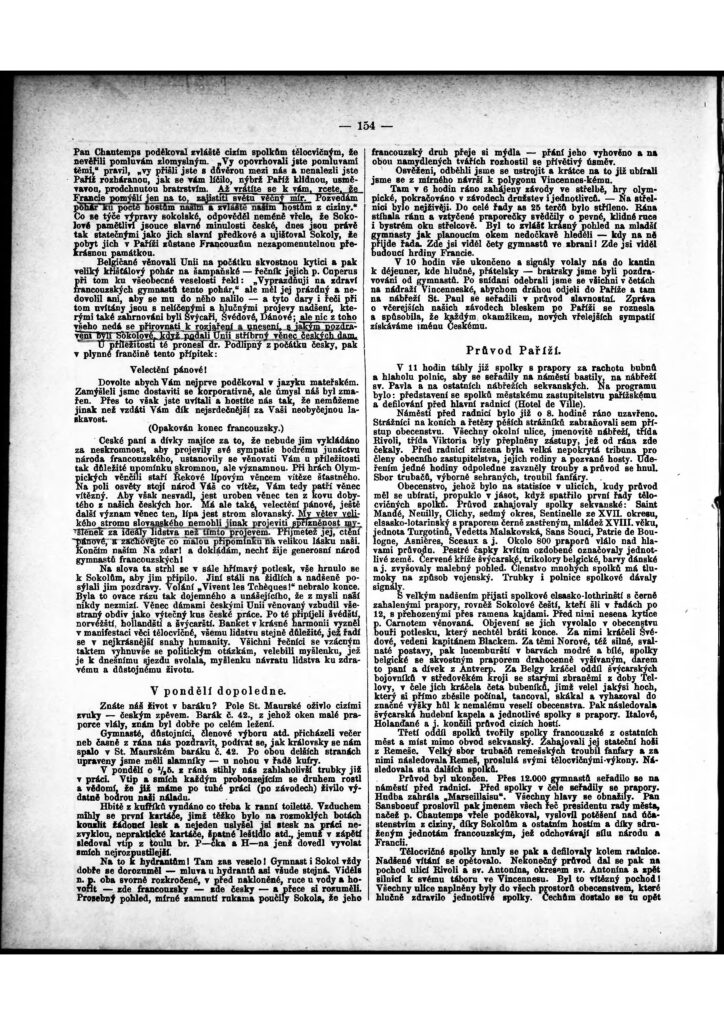

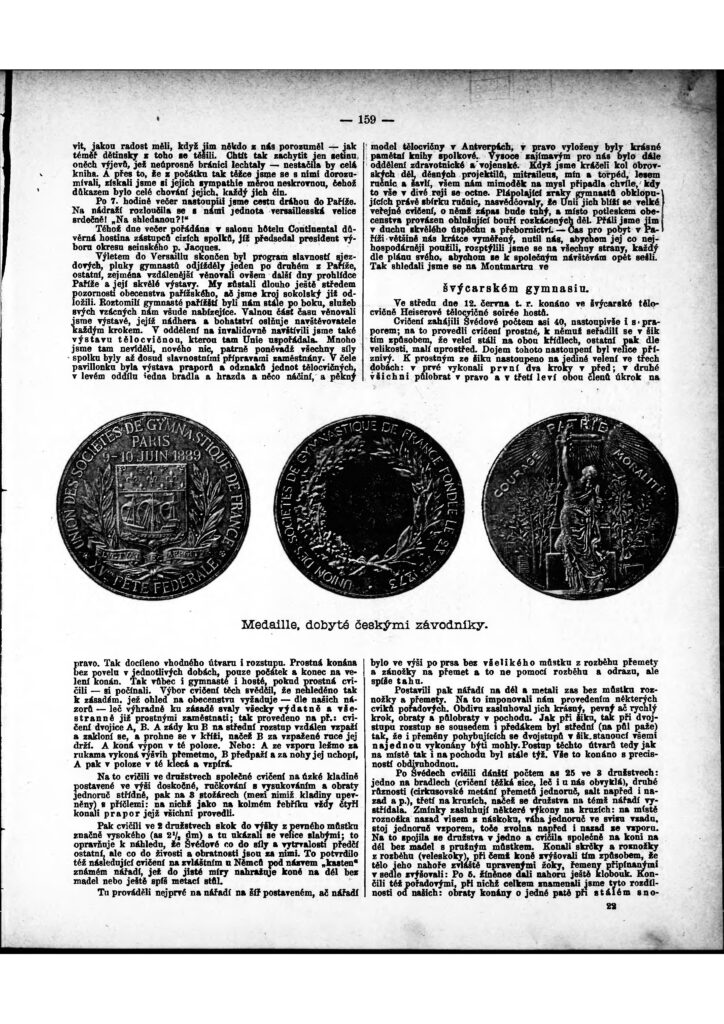
The Danes
Much to my surprise, I was able to find the report from the Copenhagen Society.
It includes an example of a preliminary exercise:
1. Formation for exercises
2. Rise on your tiptoes.
3. Turn your head right and left.
4. Throw the arms, with bending, over the shoulders, extend them sideways and bring them back to the body in the same way.
5. Bending and straightening of the knees.
6. Twists of the body.
7. Throw the arms forward, bending them, extend them back and bring them back to the body in the same way.
8. Alternate knee bends.
9. Knee bends with feet together.
10. Bend your body forward and backward.
11. Movement of the arms back.
12. Jumps in place.
13. Lateral bends of the body.
14. Spinning of the arms.
15. Alternately raise the knees.
16. Circular movement of the trunk.
17. Throw the arms above the shoulders, flexing, and bring them back in the same way.
18. Throw the arms forward, flexing, and bring them back in the same way.
In other words, imagine a mass group warm-up. That’s what the preliminary exercise was.












The French
You can also read the French report from La Gymnastique here:
